Take Me to the Recipes
“Tell me what you eat, and I will tell you who you are.” These words, attributed to the French gastronome Jean Anthelme Brillat-Savarin, encapsulate the essence of French cuisine. Beyond mere sustenance, food in France is a cultural treasure—a passport to understanding its people, history, and landscapes.
Forget tired stereotypes of croissants and cafes – French cuisine is a vibrant tapestry woven from history, geography, and a deep-seated love for good food. It’s more than just delectable dishes; it’s a cultural cornerstone, a national identity proudly displayed on every plate.
Imagine sun-drenched vineyards cradling grapes for world-renowned wines, coastal villages boasting the freshest seafood, and verdant valleys nurturing rich cheeses – each region infusing its unique flavors into the culinary symphony.
Join us as we delve into the soul of French food, exploring its historical echoes, geographical influences, and unique ingredients, all while understanding why it’s much more than just a meal – it’s a cultural treasure. Bon appétit!
Take Me to the Recipes
Key Takeaways
- French Cuisine is a global sensation, renowned for its elegance and sophistication.
- French gastronomy is rich in traditions, cooking techniques, and flavors that make it unique and distinctive.
- French culinary arts and history are deeply rooted in the cultural identity of France.
- From traditional dishes to Michelin-starred restaurants, French Cuisine offers a diverse range of culinary experiences.
- By embracing the flavors and savoring the traditions of French gastronomy, you can enhance your culinary experiences and appreciate the cultural significance of food.
Where is France?

France, borders touch Germany and Belgium in the north; Switzerland and Italy in the East and the Atlantic Ocean in the west; the Pyrenees Mountains and Spain in the south.

Index to the Contents
- Take Me to the Recipes
- More Articles
- 10 Fascinating Facts about France
- French History and the Effect It Has Had on the Cuisine
- How did the French Revolution affect food in France?
- How France’s Climate and Geography Have Influenced French Cuisine
- Understanding the Essence of French Cuisine
- French Culinary Traditions
- Exploring France’s Ingredients: The Flavors of French Cuisine
- Mastering French Cuisine Cooking Techniques
- Traditional Examples of French Food
- Exploring French Street Food
- The Most Popular French Recipes
- What are the Health Implications of French Cuisine?
- France’s National Dish
- Classic French Recipes to Try at Home
- Conclusion
- FAQ’s
You may also Enjoy the Following Articles
- North and South American Cuisine – A Culinary Expedition
- European Cuisine: Savor the Continent’s Best Culinary Secrets!
- African Cuisine: Discover the Bold Flavors & Global Charm!
- Asian Cuisine Unlock its Secrets – Taste, Health & Global Influence!
- Oceania Cooking: A Culinary Journey Through the Pacific
Savor iconic French Food Recipes – Click on each tantalizing picture to open up the Recipe.
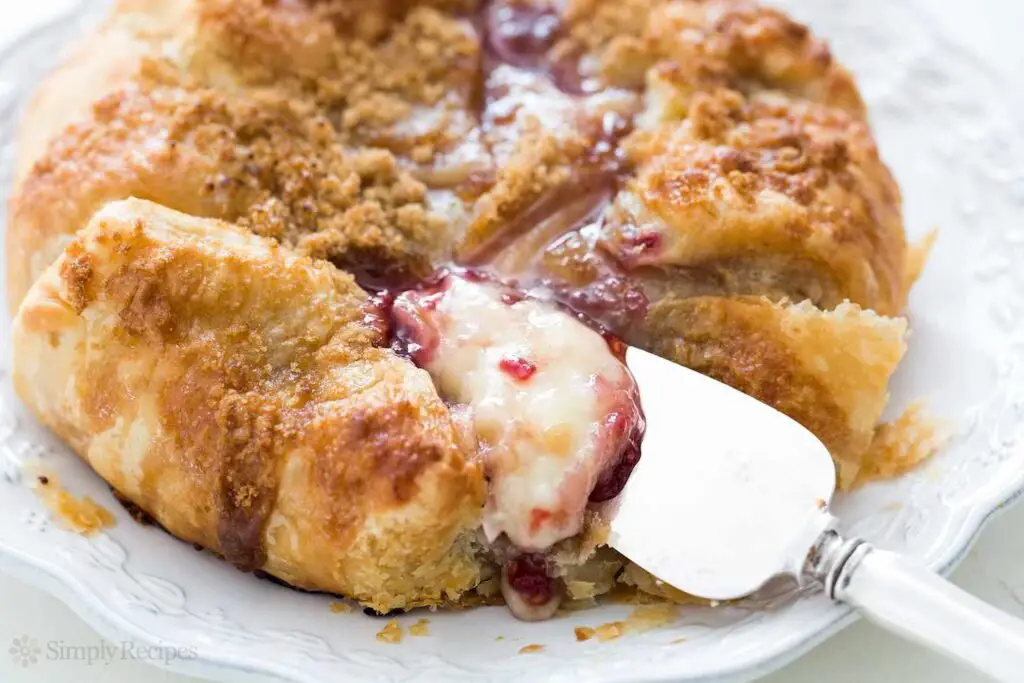

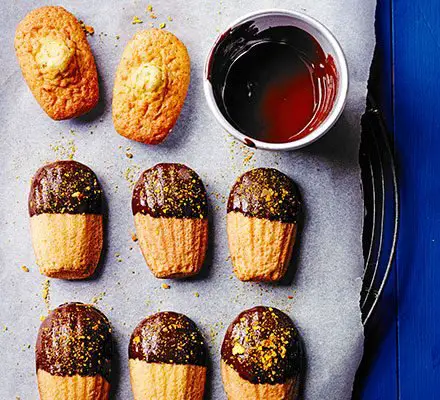
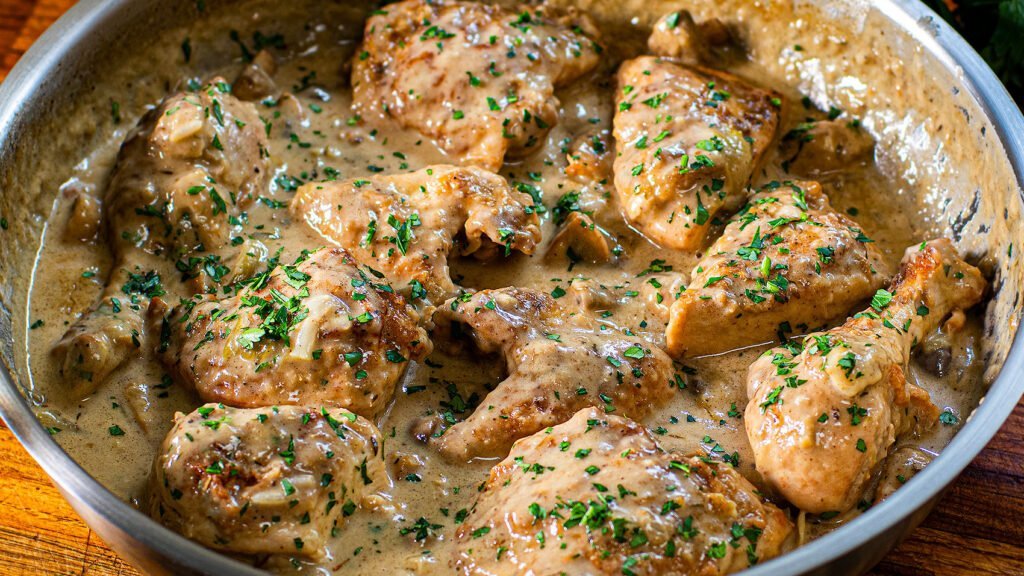
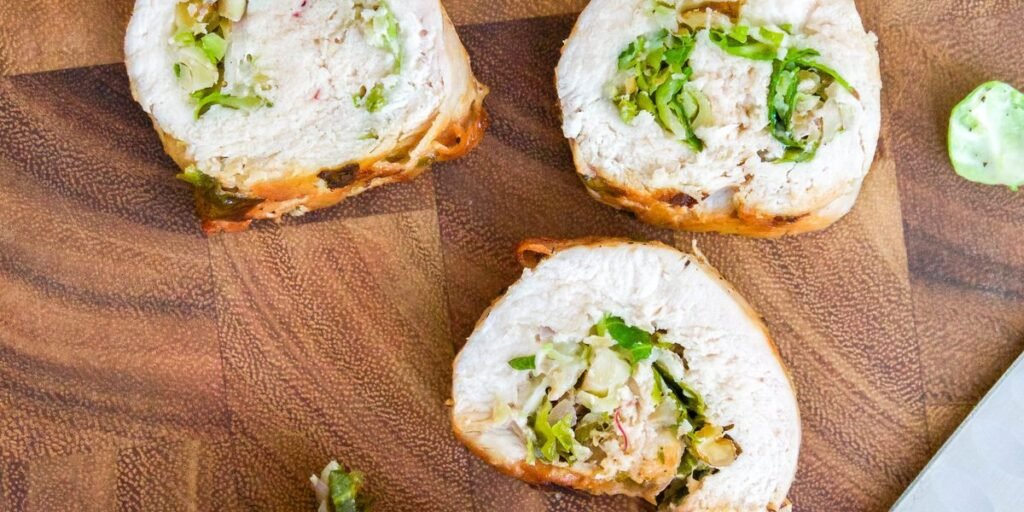
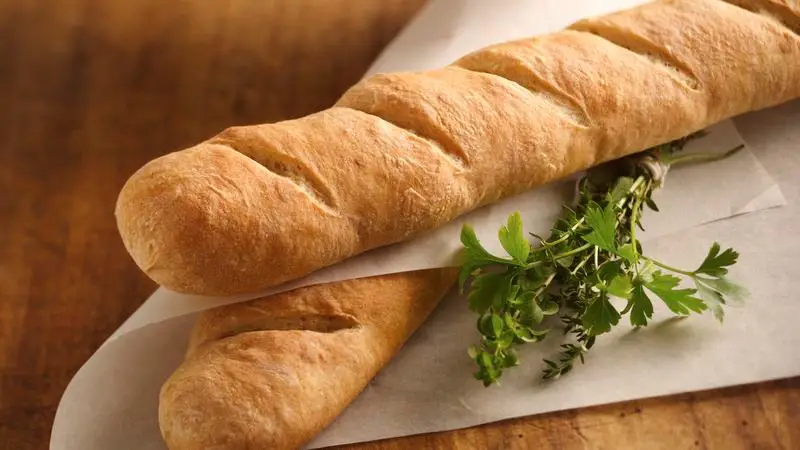
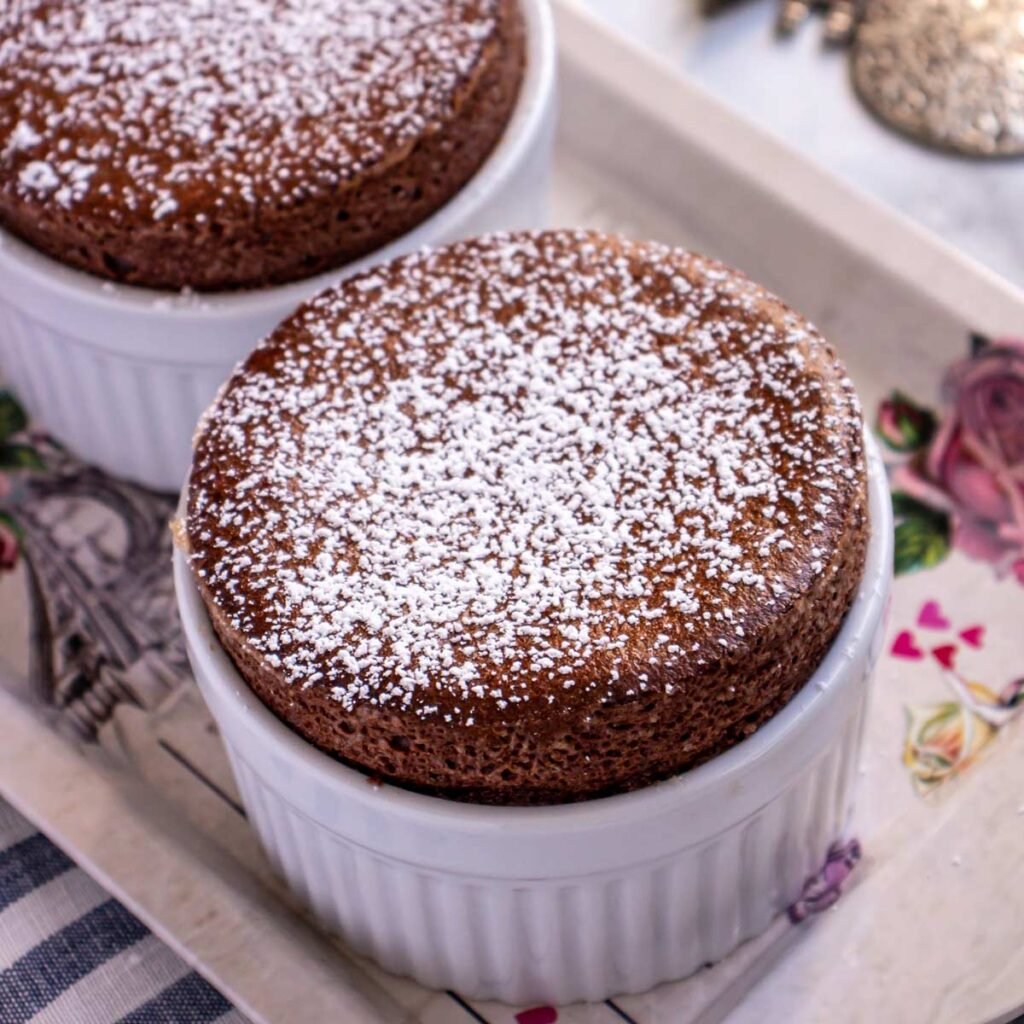




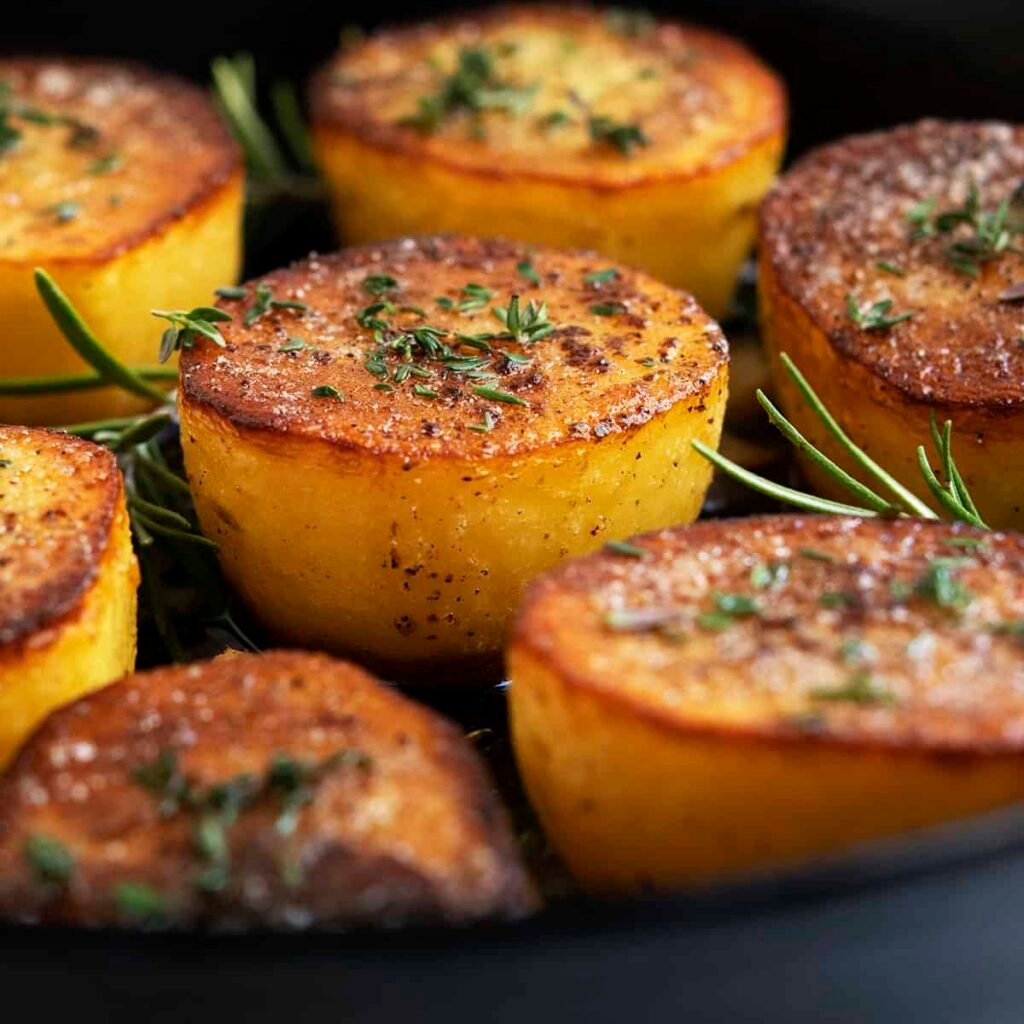
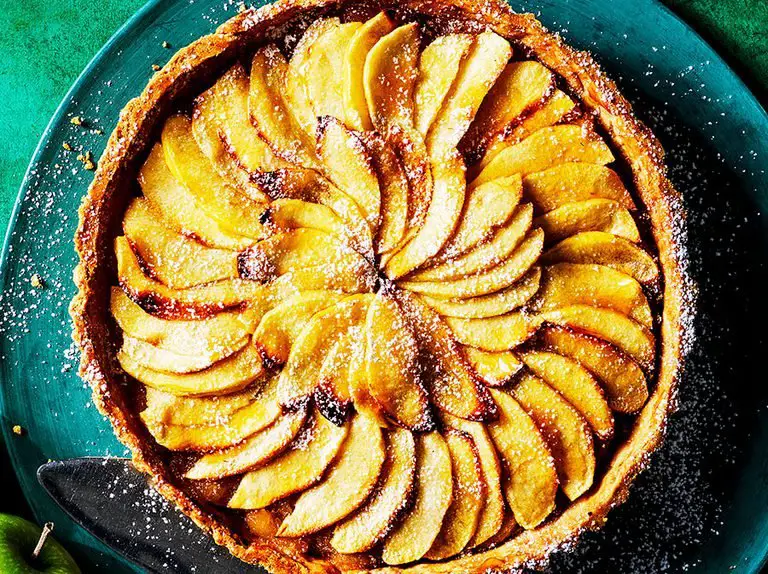
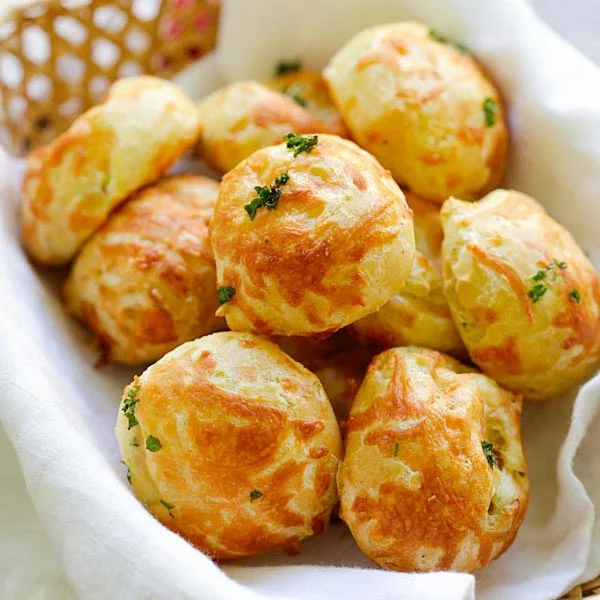
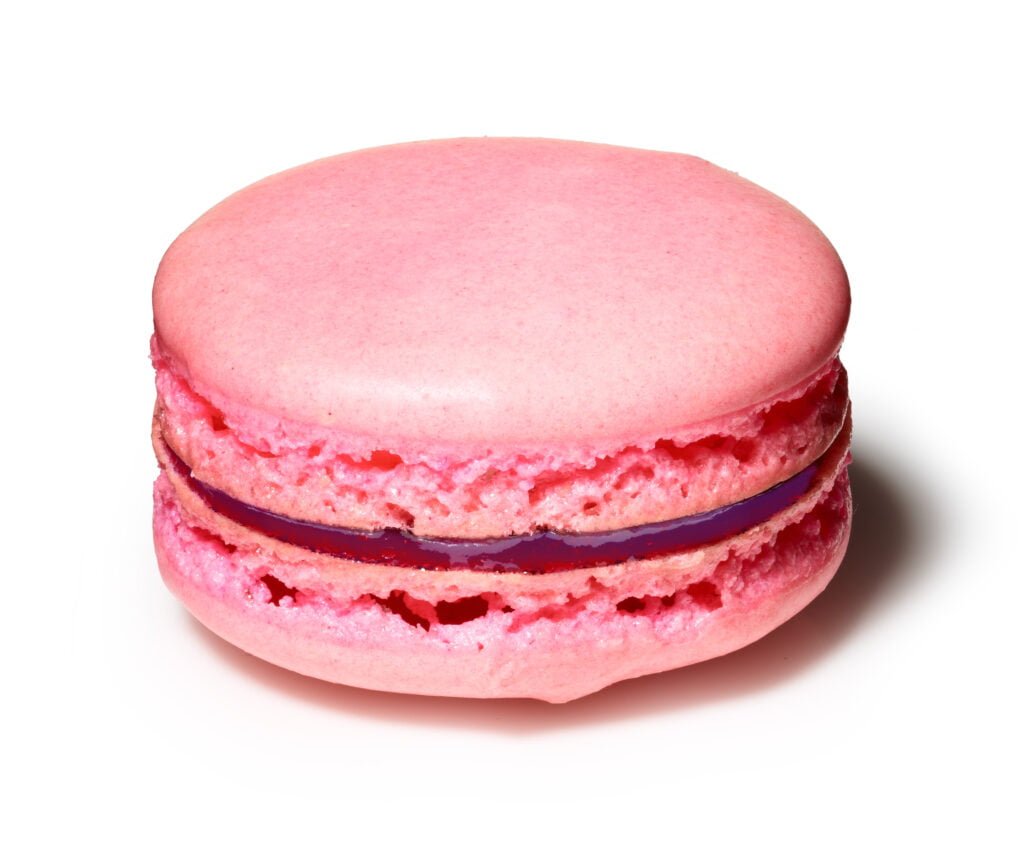

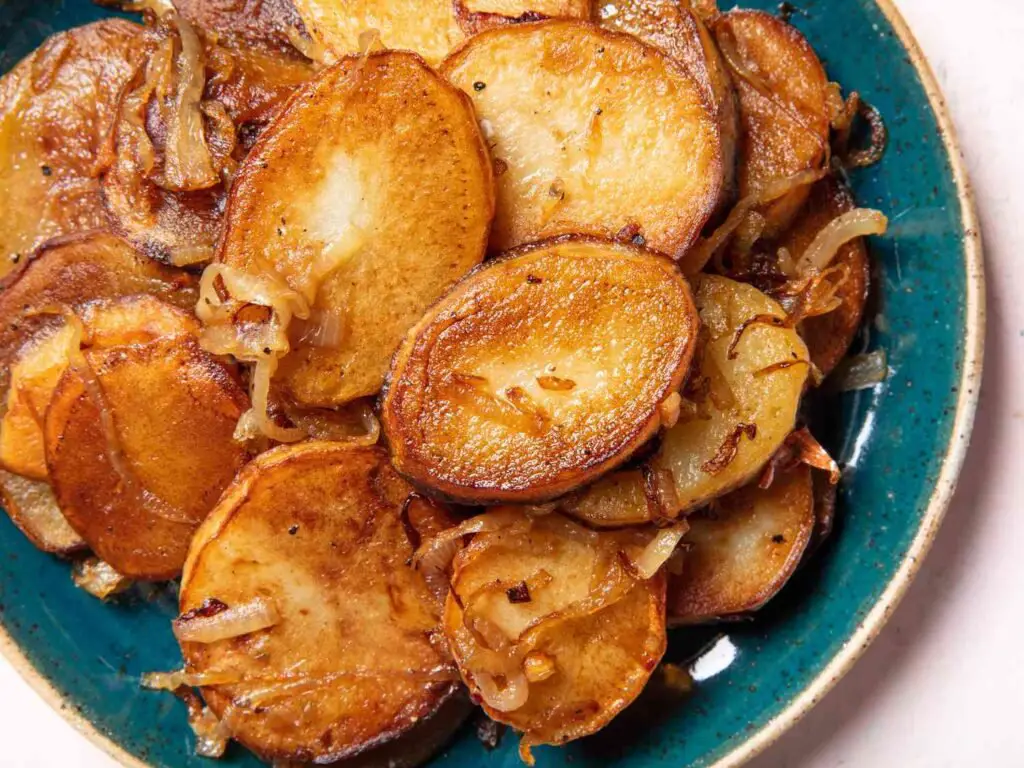
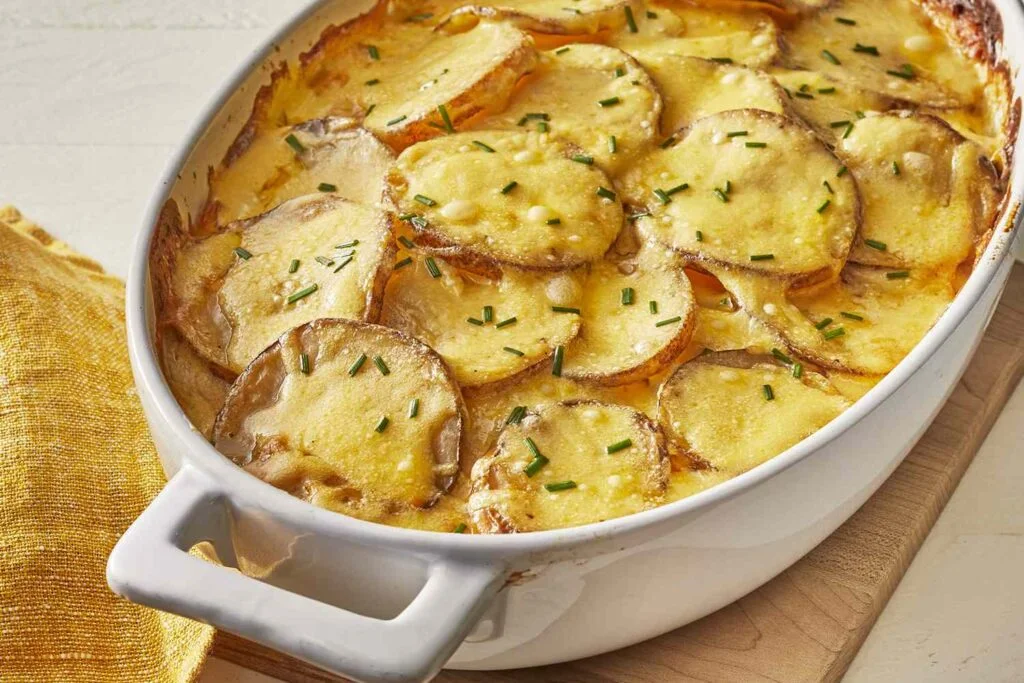



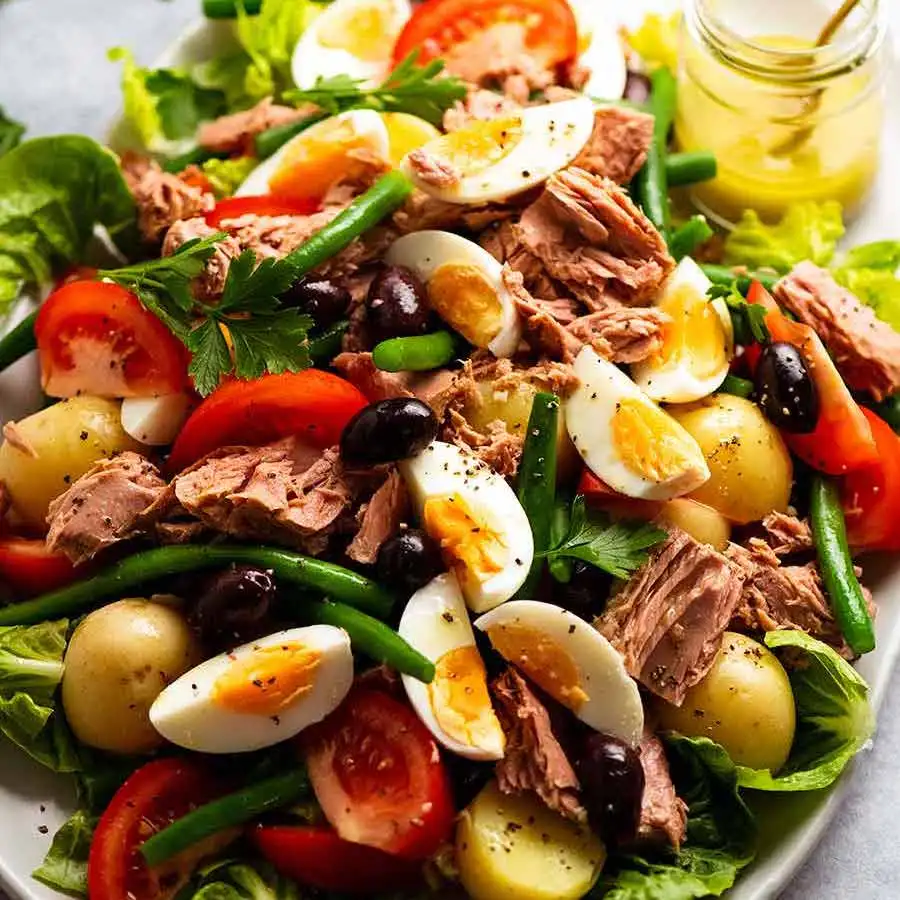
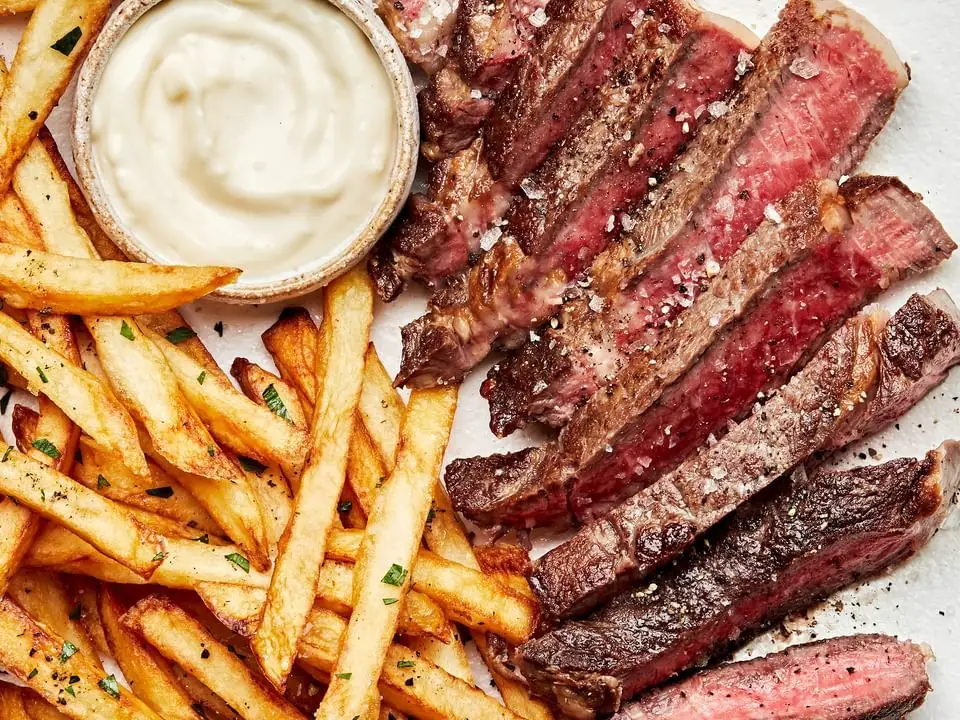
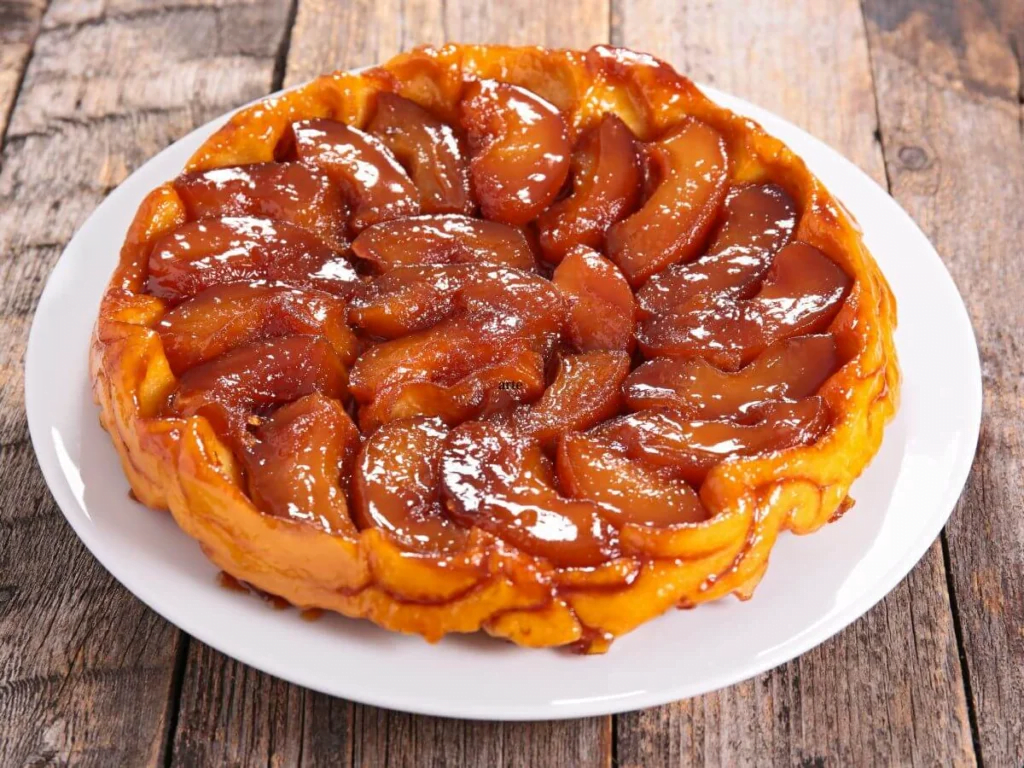
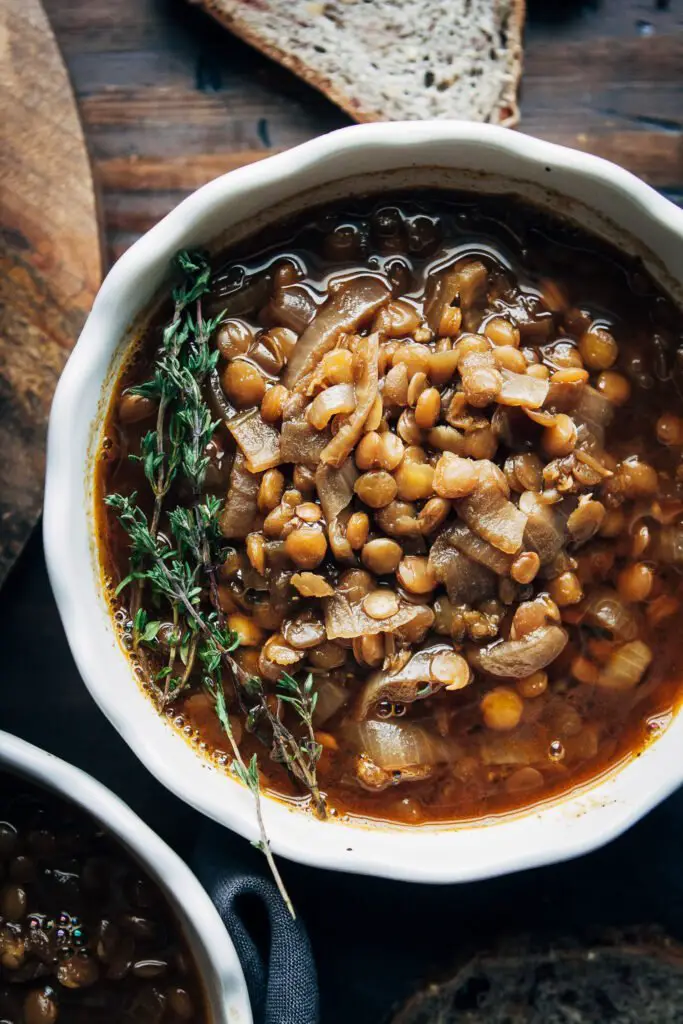
10 Fascinating Facts about France
France, the land of romance, revolutions, and, of course, delicious pastries, holds more than its fair share of surprises.
From historical oddities to cultural quirks, here are 10 fascinating facts about France and its people that will pique your curiosity and leave you wanting to explore more:
The Eiffel Tower Was Almost Scrapped
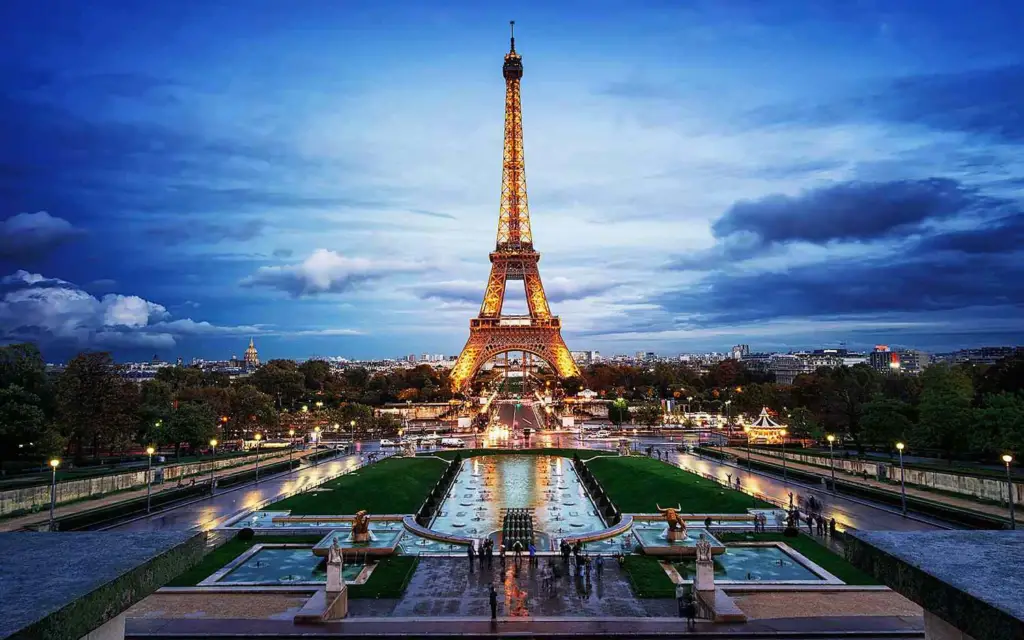
Can you imagine Paris without its iconic iron lady? The Eiffel Tower, initially intended as a temporary World’s Fair exhibit, faced demolition after 20 years. Luckily, its use as a radio antenna saved it, transforming it into the beloved landmark it is today.
The Land of Snail Lovers
Don’t be squeamish! France consumes a whopping 25,000 tons of snails each year, often enjoyed with garlic butter and crusty bread. This delicacy, escargot, is a national treasure, savored for its unique flavor and cultural significance.
The French Don’t Say “I Love You” Lightly
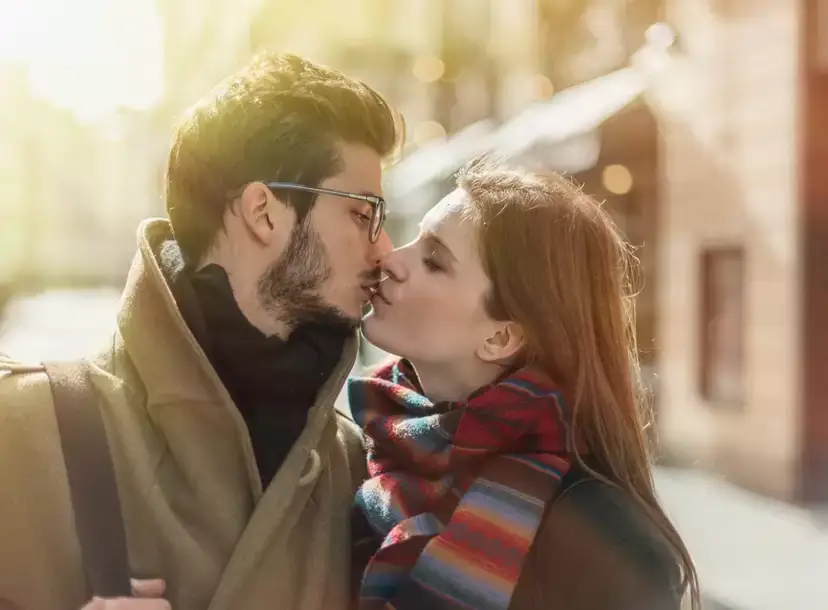
Unlike their Hollywood portrayals, the French use “je t’aime” (I love you) sparingly, reserving it for deep, emotional connections.
They prefer “je t’adore” (I adore you) for everyday affection, showing their love through actions and gestures rather than just words.
Kissing on Train Platforms is (Officially) Forbidden
In 1910, a law was passed banning kissing on train platforms to prevent delays caused by romantic farewells. While rarely enforced today, it serves as a reminder of a time gone by and the French penchant for etiquette.
France Has More Than 400 Cheese Varieties
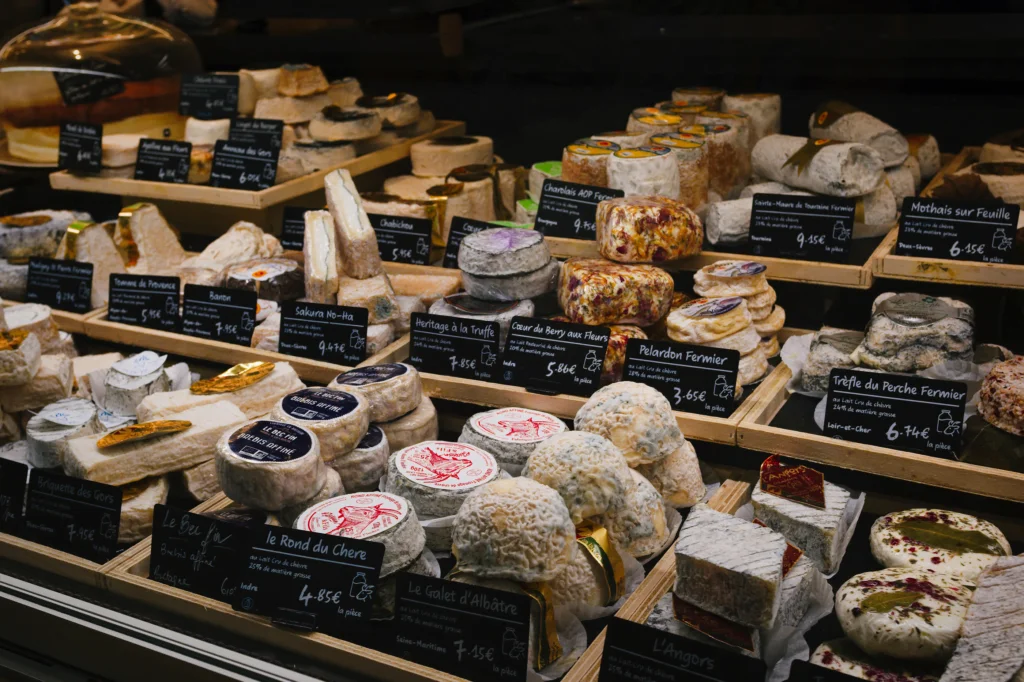
From the creamy Brie to the pungent Roquefort, cheese is a cornerstone of French cuisine. With over 400 distinct types, each region boasts its own specialty, reflecting the diverse landscapes and culinary traditions of the country.
The French Take Their Bread Seriously
Bread is more than just a staple in France; it’s an art form. There are strict regulations governing its production and sale, and even supermarkets face fines for selling stale bread. Baguettes, with their golden crust and airy interior, are a national treasure enjoyed at every meal.
They Invented the Hot Air Balloon (and Used It to Escape Prison)
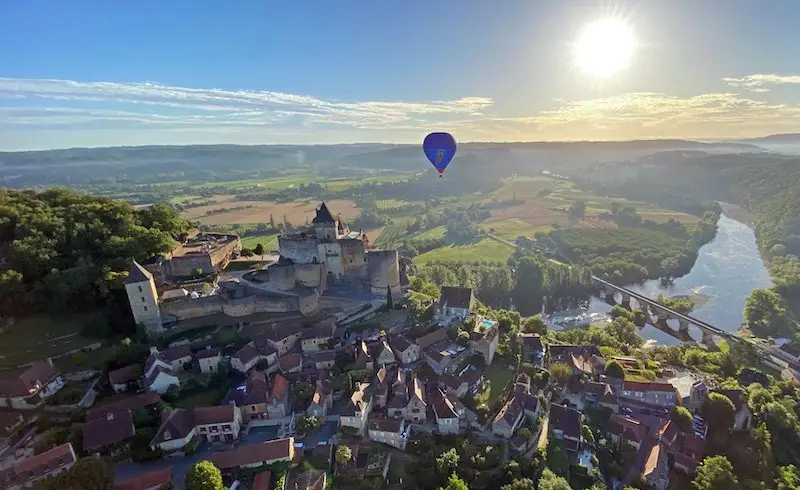
In 1783, the Montgolfier brothers launched the first hot air balloon flight, defying gravity and capturing the world’s imagination. Ironically, just a few years later, a French prisoner used a hot air balloon to escape jail, proving that innovation can be used for good (and bad)!
France Has a President of the Republic…and a President of Snails
Yes, you read that right! Since 1983, the Brotherhood of Snail Masters has elected a “President of the Republic of Snails” to promote and protect the art of snail farming and consumption. Talk about niche elections!
The French Have a Unique Relationship with Silence
Unlike many cultures, the French embrace comfortable silences during conversation. They see them as opportunities for reflection and contemplation, rather than awkward pauses to be filled with nervous chatter.
They Celebrate April 1st… Differently
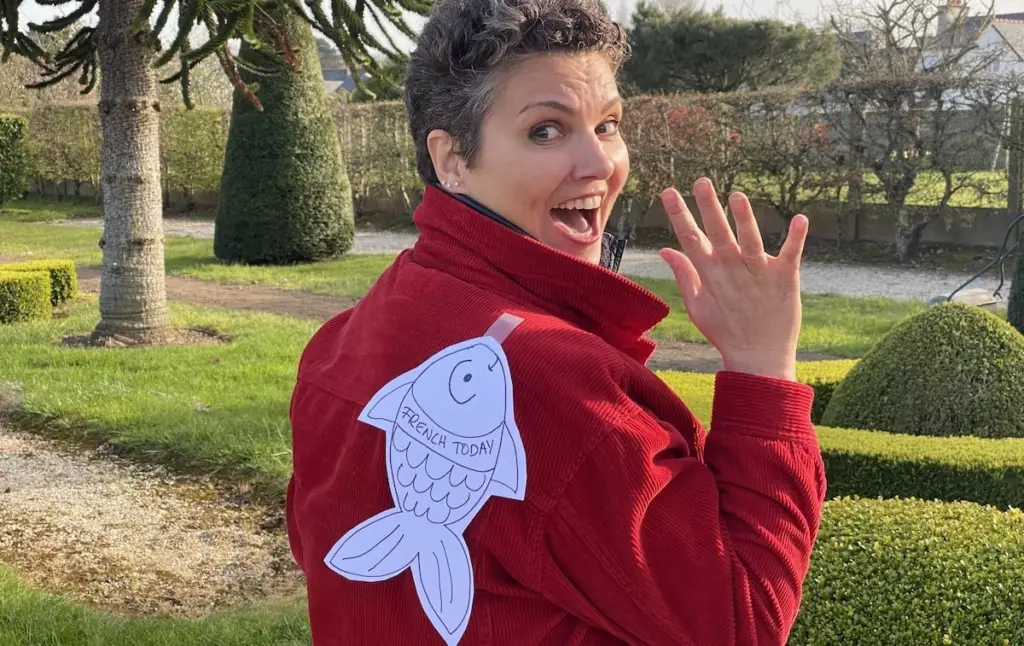
While most countries celebrate April Fool’s Day with pranks, France has “Poisson d’Avril” (April Fish). People stick paper fish on the backs of others as a lighthearted prank, a tradition with origins dating back centuries.
These are just a few of the many fascinating facts that make France such a unique and captivating country.
French History and the Effect It Has Had on the Cuisine

Buckle up, food lovers, as we explore the fascinating periods that transformed simple meals into the gourmet masterpieces France is known for today.
Prehistory (Before Recorded History)
Imagine prehistoric humans in Gaul, gathering wild bounty – plump berries, fresh fish, and succulent game. Their ingenuity laid the foundation of French cuisine, using fire for simple roasting and boiling, laying the groundwork for generations to come.
Classical Era (600 BC – 476 AD)
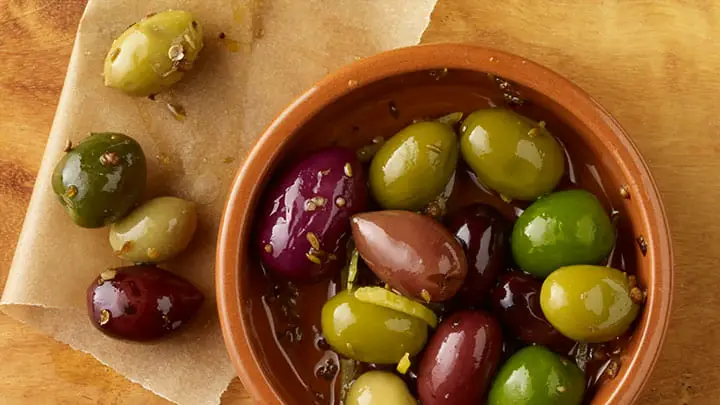
Fast forward to Roman rule, and Gaul transforms into a culinary melting pot. Olives, wine, and spices like pepper and cumin waltz onto the scene, courtesy of their Roman neighbors.
Elaborate banquets become the norm, and the art of creating flavorful sauces takes root, leaving an enduring mark on French cuisine.
Middle Ages (5th – 15th Century)
Enter the era of knights and castles. Feudal society brings diverse culinary traditions to the table. Monasteries become hubs of culinary innovation, meticulously preserving and developing recipes.
Spices like saffron and ginger add a touch of magic, while lavish feasts showcase the opulence of the time.
Early Modern Era (16th – 18th Century)

The Renaissance brings a wave of refinement. Enter François Pierre La Varenne, the culinary rebel who introduces “nouvelle cuisine,” emphasizing lighter sauces and delicate flavors.
Meanwhile, exploration opens doors to exotic ingredients like coffee, chocolate, and spices from the East, further enriching the French palate.
French Revolution and Napoleonic Era (Late 18th – Early 19th Century)
The revolution throws a wrench in aristocratic dining. Simplicity and equality become the new mantras, reflected in lighter dishes and smaller portions.
But Napoleon, a foodie at heart, spreads French culinary techniques across Europe during his conquests, ensuring its global influence.
Industrial Revolution and Belle Époque (19th Century)
Cities bustle, and with them come new eating habits. Haute cuisine reaches its peak, with renowned chefs codifying culinary techniques and creating iconic dishes like “soufflés” and “crème brûlée.”
Meanwhile, cafes and brasseries become the social hubs, offering casual yet delicious fare.
World Wars and Post-War Period (20th Century)
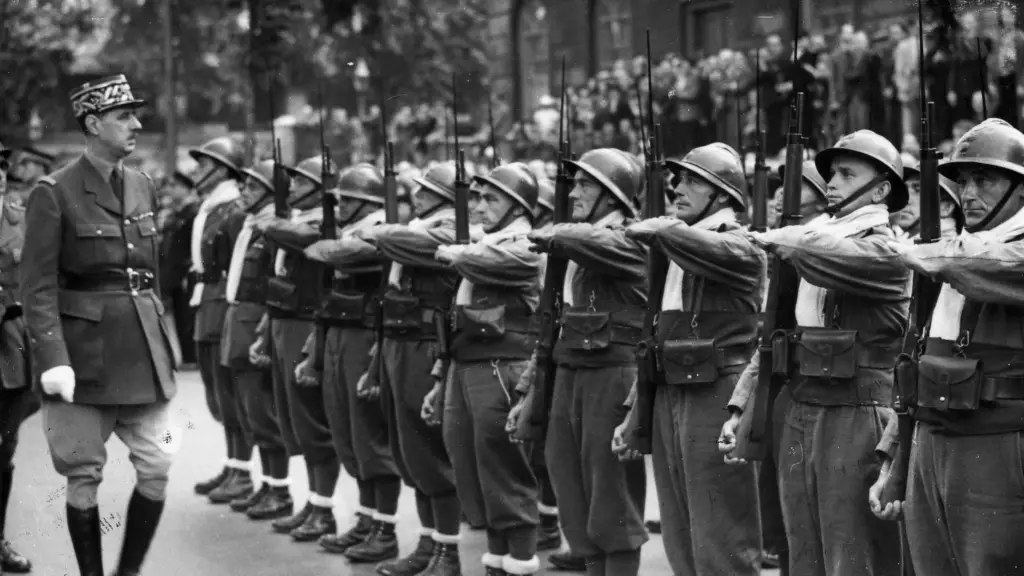
War casts a shadow, bringing food shortages, rationing, and the rise of canned and frozen goods. But amidst the hardship, innovation thrives.
Post-war, “nouvelle cuisine” emerges, championing fresh, seasonal ingredients and minimalist presentations.
Contemporary Era (Late 20th Century – Present)
France remains a culinary powerhouse, constantly evolving. Renowned chefs like Alain Ducasse and Anne-Sophie Pic push boundaries, while regional specialties like “bouillabaisse” and “cassoulet” continue to captivate. Fusion cuisine takes center stage, with global influences adding exciting new flavors to the mix.
So, the next time you savor a decadent French dish, remember the rich tapestry of history woven into each bite. From humble beginnings to global acclaim, French cuisine is a testament to human ingenuity, cultural exchange, and a deep love for the art of good food.
References
How did the French Revolution affect food in France?
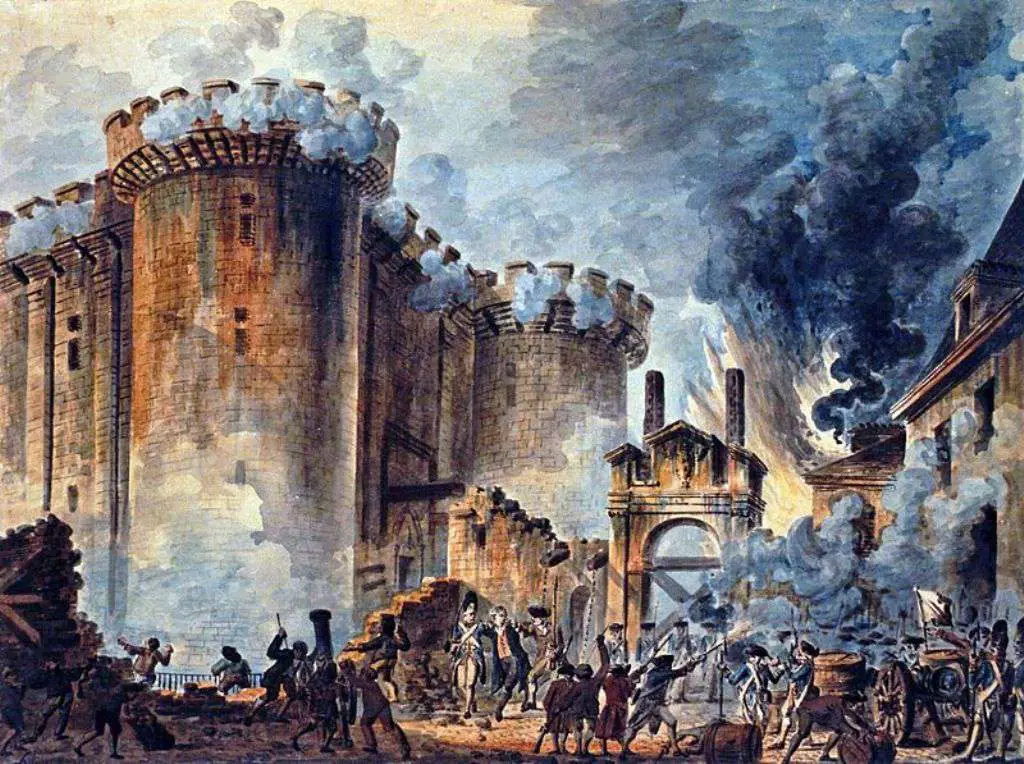
The French Revolution (1789-1799) didn’t just topple kings, it upended plates too! Let’s delve into this tumultuous period and see how it transformed French cuisine, bite by revolutionary bite:
Farewell Feasts
Imagine multi-course banquets fit for royalty, then picture them vanishing overnight. The revolution abolished the aristocracy, and with them went their extravagant dining habits.
French citizens craved equality, and that extended to their plates – simpler, more egalitarian fare became the new normal.
Marie Antoinette and the “Let Them Eat Cake” Myth

The oft-repeated story about Marie Antoinette responding to news of her subjects’ bread shortage with the line, “Let them eat cake” (actually, brioche), is likely not true.
The revolution’s impact transcended the beheading of monarchs. It fundamentally altered French food culture, shattering the elaborate banquets of the aristocracy and paving the way for a more egalitarian approach to dining.
Gone were the multi-course feasts; in their place emerged simpler, more accessible dishes that reflected the changing social landscape.
This shift wasn’t just about scarcity; it was about reclaiming food as a shared experience, not a symbol of privilege. Regional specialties like coq au vin and bouillabaisse gained prominence, showcasing the diverse culinary tapestry of France.
Even today, the emphasis on fresh, local ingredients and seasonal flavors in French cuisine echoes the spirit of the revolution – a testament to the enduring impact of those tumultuous times.
So, the next time you hear the “Let them eat cake” myth, remember it’s not just a catchy phrase, it’s a reminder of a pivotal moment in history and its lasting influence on the world of food. It’s a reminder that food is more than just sustenance – it’s a cultural touchstone, a reflection of society, and a powerful symbol of change.
Lost Knowledge and Scarcity
Monasteries, treasure troves of culinary knowledge and recipes, were disbanded. Guilds controlling professions, like bakers and butchers, also dissolved. Food shortages, fueled by war and economic upheaval, added another layer of hardship.
But resourceful citizens didn’t crumble – they adapted. Rationing became the norm, and creativity bloomed, transforming humble ingredients into delicious necessities.
The Sans-Culottes’ Culinary Revolution

Imagine a radical working-class group, the Sans-Culottes, leading the charge for practical, frugal meals.
Their influence saw rustic dishes like stews and pottages gain popularity, reflecting the times and the need for sustenance over extravagance.
Nationalism on a Plate
As revolutionary fervor rose, so did a sense of national identity. Regional specialties like coq au vin and bouillabaisse gained prominence, solidifying the concept of “French cuisine” as something distinct and proud.
Luxury Lost, Simplicity Gained
Trade routes were disrupted, leaving once-cherished luxury ingredients like truffles and exotic spices out of reach. But necessity became the mother of culinary invention – simplicity reigned supreme, and French chefs
learned to create remarkable dishes with readily available ingredients.
Cookbooks in Crisis
Even amidst the chaos, cookbooks didn’t disappear. Authors adapted, creating recipes using affordable ingredients and showcasing resourceful techniques born from scarcity.
These works became testaments to French culinary ingenuity and adaptability.
A Legacy of Change
The revolution’s impact on French food culture was profound and lasting. It paved the way for modern French cuisine, emphasizing local, seasonal produce, accessibility, and resourcefulness.
So, the next time you savor a perfectly cooked coq au vin or a hearty lentil stew, remember – it’s not just a delicious meal, it’s a taste of history!
References
How France’s Climate and Geography Have Influenced French Cuisine
Close your eyes and imagine: sun-drenched vineyards cradling Bordeaux grapes, cool Atlantic breezes whipping over Brittany oysters, and the smoky allure of Roquefort cheese maturing in limestone caves.
This isn’t just a geography lesson – it’s a delectable journey through the diverse tapestry of French cuisine!
Nature’s Masterpiece

Each region of France boasts a unique “terroir,” a magical blend of soil, climate, and environment that whispers its secrets into every bite. In Bordeaux, those whispers sing of Cabernet Sauvignon grapes ripening under warm sunshine, resulting in world-renowned wines.
Meanwhile, the Mediterranean coast basks in sunshine, offering up an abundance of seafood that finds its way into steaming bowls of bouillabaisse. Cross over to the Atlantic coast and savor the buttery richness of Normandy, where creamy Camembert cheese and succulent oysters reign supreme.

Climb the mountains and discover hearty stews bubbling in cast-iron pots, fueled by the Alpine air and accompanied by savory cured meats.
A Symphony of Flavors

Beyond the landscape, history hums in every dish. The Roman influence lingers in the love for olives and sauces, while medieval monasteries preserved culinary knowledge and nurtured vineyards. Royal courts birthed haute cuisine, with its intricate presentations and refined flavors.
And the French Revolution democratized dining, simplifying recipes and celebrating regional specialties.
A Taste of Every Region
Alsace, with its Germanic heritage, offers up tangy sauerkraut and flammekueche (tarte flambée). Provence, bathed in Mediterranean sunshine, bursts with the vibrant flavors of ratatouille and lavender-infused dishes.
Brittany, a coastal haven, beckons with the irresistible combination of crêpes and fresh seafood. Lyon, the culinary capital, boasts Lyonnaise sausages and bouchons, bustling bistros serving local delicacies.
Bordeaux, of course, pairs its duck confit with a glass of its own exquisite wine, while Normandy offers Camembert and apple-based delights like Calvados.
Bon Appétit!
France’s diverse landscapes, climates, and history have woven a rich tapestry of regional cuisines. Each bite is a celebration of unique ingredients, traditions, and a culinary heritage as vibrant as the land itself.
So, grab your fork and embark on a delicious journey – from the sun-kissed vineyards to the charming villages, every region of France promises a culinary adventure that will tantalize your taste buds and leave you wanting more.
References
- Exploring the Influence of Geography on French Cuisine
- French Food And Its Regional Influences
- France – Culture, Cuisine, Arts
Understanding the Essence of French Cuisine
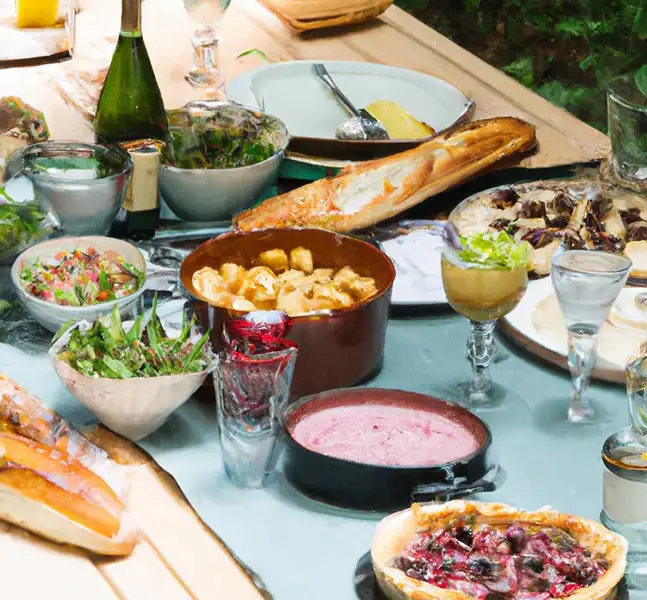
Bonjour, fellow food enthusiasts! Buckle up as we embark on a culinary journey to explore the essence of French cuisine. But before we dive into the buttery depths of béchamel and the flaky layers of croissants, let’s address the burning question on everyone’s mind:
What Exactly Constitutes ‘French Food’?
To the uninitiated, French cuisine may seem like a mystifying melange of cheese, croissants, and escargots. Fear not, dear foodies! We’re here to unravel the mysteries of this gastronomic gem and decode what truly classifies as quintessential French fare.
From the art of sauce-making to the mastery of flavor pairing, let’s explore what makes French cooking so utterly captivating.
The Evolution of French Cuisine
French cuisine isn’t just about baguettes and berets; it’s a culinary saga that spans centuries. Here’s a taste of its evolution:
- The Influence of Regional Cuisines:
- The distinctiveness of French cuisine lies in its ability to embrace regional variations. Each province showcases a rich tapestry of flavors and techniques.
- From the hearty, meat-centric dishes of the north (think boeuf bourguignon) to the lighter, seafood-focused creations of the coast (hello, bouillabaisse), France’s culinary landscape mirrors its cultural and geographical diversity.
- Historical and Cultural Factors:
- France’s long history of political fragmentation birthed a mosaic of regional identities, each with its own distinctive cuisine.
- Climate, agricultural practices, and social customs shaped local traditions, resulting in a wide array of culinary styles unique to their respective regions.
- Preserving Authenticity:
- Renowned chefs have made it their mission to protect and promote regional specialties. These culinary treasures remain integral to France’s gastronomic heritage.
- From Normandy’s Camembert to Provence’s ratatouille, these dishes have gained international recognition.
A Taste of French Simplicity
Picture this: a sun-kissed Parisian afternoon. You’re sitting at a sidewalk café, sipping a robust espresso. What’s on your plate? A baguette and a wedge of creamy cheese. This humble combination represents the very essence of French cuisine:
- Simplicity: French cooking values quality over complexity. The baguette and cheese require no elaborate preparation, yet they deliver a rich and satisfying taste experience.
- Flavor: Whether it’s a delicate coq au vin or a rustic tarte Tatin, French dishes prioritize flavor above all else.
Adaptation and Evolution
While regional character remains vital, French cuisine has also adapted and evolved:
- Modern Inspiration: Chefs draw inspiration from international cuisine, technological advancements, and environmental concerns.
- Innovation: Think molecular gastronomy, sous-vide cooking, and edible flowers. French chefs push the boundaries while honoring tradition.
Bon Appétit!
In the heart of France, culinary magic unfolds. From the bustling markets of Provence to the vineyards of Bordeaux, French cuisine is a symphony of flavors, a celebration of terroir, and an ode to the joy of sharing a meal with loved ones.
So, next time you savor a croissant or sizzle a duck confit, remember that you’re partaking in a centuries-old legacy—a delicious dance that transcends borders and tantalizes taste buds.
Allez, mes amis! Let’s raise our glasses (of Bordeaux, bien sûr) and toast to the enduring allure of French cuis
Acknowledgement
Consider diving into Michel Roux’s book, The Essence of French Cooking. It’s a culinary treasure trove that celebrates the soul of French gastronomy.
French Culinary Traditions

The culinary traditions are a testament to the country’s love affair with food. From the “repas gastronomique,” recognized by UNESCO as an intangible cultural heritage, to the daily ritual of breaking bread, food is integral to French culture.
Traditions such as the long lunch, the cheese course, and the use of seasonal produce are not just customs but a way of life. These traditions are preserved and passed down through generations, ensuring that the essence of French cuisine remains alive.
Exploring France’s Ingredients: The Flavors of French Cuisine

French cuisine is an orchestra of ingredients, each playing a vital role in composing symphonies of taste. From the delicate whispers of herbs to the bold declarations of cheeses, each bite is a journey through diverse landscapes and centuries of culinary tradition.
Buckle up, food adventurers, as we delve into the soul of French cuisine through its essential ingredients:
The Green Chorus
Fresh herbs are the vibrant sopranos of French cooking, adding life and depth to every dish. Parsley, the ubiquitous star, brings freshness, while thyme, tarragon, and bay leaf offer their unique harmonies.
Rosemary adds a powerful alto with its woody notes, perfect for stews and roast meats. Chervil, the delicate soprano, lends a subtle sweetness to salads and omelets.
The Creamy Basso Profundo
French dairy products are the rich bassos of the culinary orchestra. Butter, the foundation of many sauces and pastries, provides a velvety texture and nutty flavor.
Cheese, a world of its own, offers endless possibilities – from the sharp tang of Roquefort to the creamy luxury of Brie. Crème fraîche adds a touch of tang and richness to soups, sauces, and desserts.
The Earthy Ensemble
Onions, garlic, and shallots form the earthy backbone of French cuisine. Onions, caramelized or sautéed, add sweetness and depth. Garlic, pungent and versatile, is a must-have in countless dishes.
Shallots, more delicate than onions, lend a subtle sweetness to sauces and vinaigrettes.
The Spicy Accent
French cuisine isn’t about fiery heat, but subtle spice accents. Dijon mustard, with its grainy texture and sharp bite, adds depth to sauces and vinaigrettes.
Fleur de sel, a delicate finishing salt, enhances the natural flavors of ingredients. Black pepper, freshly ground, adds a touch of heat and complexity.
The Fruity Interludes

French cuisine embraces the subtle sweetness of fruits. Apples, both sweet and tart, are featured in Calvados, pastries, and savory dishes like duck à l’orange. White wine adds acidity and depth to sauces and stews.
Vinegar, from red wine to balsamic, brings a touch of acidity and complexity.
The Smoky Echoes
Smoked ingredients add intrigue and complexity. Pancetta adds a salty, smoky note to pasta dishes and soups. Andouille, a smoked sausage, brings a spicy kick to choucroute garnie. Smoked duck lends a unique depth to salads and appetizers.
Beyond Ingredients, a Culture
French food ingredients are more than just culinary components; they’re cultural touchstones. From the humble onion to the luxurious truffle, each bite whispers stories of sun-drenched vineyards, rolling hills dotted with sheep, and bustling markets overflowing with fresh produce.
So, the next time you savor a French dish, remember – it’s not just about the ingredients, it’s about the symphony of flavors they create, echoing centuries of tradition and celebrating the bounty of the land.
Mastering French Cuisine Cooking Techniques

Refined and elegant dishes are a hallmark of French Cuisine. This reputation is largely due to the sophisticated cooking techniques used by French chefs. To truly master French culinary arts, one must have a thorough understanding of these techniques. Here, we will explore some of the most important French cooking techniques that every aspiring chef should know.
French Cuisine – Sautéing
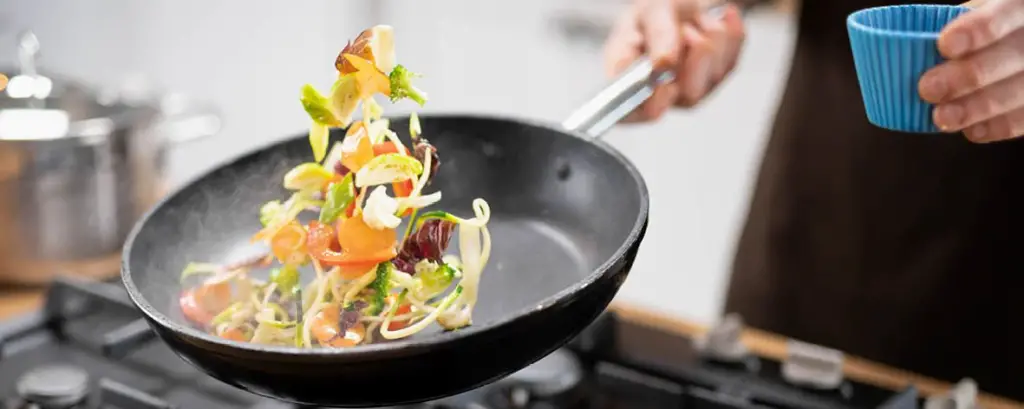
Sautéing cook food quickly over high heat. Chefs use sautéing to cook vegetables, meats, and seafood.
To sauté, heat a small amount of oil or butter in a pan over high heat. Once the oil is hot, add your ingredients and cook for a few minutes, stirring constantly. Sautéing is a quick process so don’t overcook the food.
French Cuisine – Braising

Braising is a technique that involves cooking food slowly in a liquid. Chefs use braising for tougher cuts of meat, such as beef or lamb.
To braise, sear the meat in a hot pan to give it a crust, then transfer it to a pot with a flavorful liquid, such as red wine or beef broth. Cook the meat over low heat for several hours until it is tender and falling apart.
French Cuisine – Poaching

Poaching is a gentle cooking technique that involves cooking food in simmering liquid. Chefs use poaching for delicate ingredients, such as eggs or fish.
To poach, heat a liquid, such as water or broth, in a pot until it is simmering. Add your ingredients and cook until they are tender and cooked through.
French Cuisine – Blanching

Chefs use blanching to cook vegetables briefly in boiling water, then transferring them to ice water to stop the cooking process. Blanching prepares vegetables for salads or as a precursor to further cooking methods, such as sautéing or roasting.
To blanch, bring a pot of salted water to a boil, add your vegetables, and cook for a few minutes until they are crisp-tender. Transfer the vegetables to a bowl of ice water to stop the cooking process.
These are just a few of the essential French cooking techniques to know. To truly master French Cuisine, it is important to practice and perfect these methods. With time and patience, you too can become a skilled French chef.
Traditional Examples of French Food

From hearty stews simmered in rustic kitchens to vibrant dishes reflecting regional specialties, French cuisine offers an adventure for every palate. So, pack your virtual fork and join us as we delve into five iconic French dishes that will transport you straight to the heart of culinary France:
Boeuf Bourguignon
Imagine tender cubes of beef bathed in a rich Burgundy wine sauce, infused with earthy mushrooms, pearl onions, and savory herbs. This slow-cooked masterpiece, hailing from the Burgundy region, is a symphony of flavors and textures, perfect for chilly evenings and family gatherings.
Every bite tells a story of slow cooking, patience, and the magic of simple, high-quality ingredients.
Quiche Lorraine
This savory tart boasts a buttery, flaky crust cradling a creamy custard studded with ham and melty cheese. Simple yet elegant, Quiche Lorraine originates from the Lorraine region and remains a French staple.
Enjoy it warm for brunch, a light lunch, or even as an appetizer, savoring the contrasting textures and the perfect balance of creamy custard and salty ham.
Soupe à l’Oignon
Don’t underestimate the power of this humble caramelized onion soup! Layers of slowly caramelized onions meld with rich beef broth, topped with a golden-brown crusty bread and melted Gruyère cheese. This bistro classic is a warm hug in a bowl, especially on a rainy day.
Each spoonful bursts with savory sweetness, transporting you straight to a cozy Parisian café.
Ratatouille
This vibrant Provençal stew celebrates the summer harvest with its colorful medley of tomatoes, eggplant, zucchini, peppers, and herbs. Simmered to perfection with olive oil and garlic, it’s a light and flavorful symphony of fresh vegetables, showcasing the French appreciation for seasonal ingredients and simple preparations.
Crêpes
These thin pancakes are more than just breakfast fare in France. From savory “galettes” filled with cheese, ham, and vegetables to sweet crêpes bursting with jam, Nutella, or fresh fruit, they’re a versatile and delicious street food enjoyed nationwide.
Watch them sizzle on hot plates, witness the art of flipping and folding, and then savor the explosion of flavors in every bite.
Exploring French Street Food

Imagine strolling cobbled streets, aromas of sizzling sausages and sweet pastries filling the air, and friendly vendors eager to share their culinary creations. This isn’t just a meal; it’s an immersion into French culture, a chance to savor local flavors and connect with the community.
Street Food Symphony
French street food is a symphony of textures and tastes. Crêpes, thin pancakes filled with sweet or savory delights, are a classic, enjoyed from bustling Parisian squares to charming Brittany villages.
Craving something savory? Falafel, deep-fried chickpea fritters served with creamy tahini, are a popular choice in Paris, offering a taste of the Middle East with a French twist. Don’t miss the Galette Saucisse, a buckwheat crêpe filled with a juicy sausage, a hearty treat popular in Brittany.
For a taste of pure indulgence, try the Croque Monsieur, a toasted ham and cheese sandwich with béchamel sauce. Its gooey goodness is sure to satisfy any cheese lover. And for a sweet ending, the Pain au Chocolat, a flaky croissant filled with rich chocolate, is a must-have.
City of Lights, Foodie Delights
While delicious street food can be found throughout France, some cities boast particularly vibrant scenes.
- Paris, the undisputed champion, offers a diverse array of vendors, from falafel stands in the Marais to crêpe stalls in the Latin Quarter.
- Lyon, known as the culinary capital of France, offers bouchons, small, traditional restaurants specializing in local delicacies like sausages and quenelles.
- Marseille, with its Mediterranean influences, is a haven for seafood lovers, with vendors selling fresh oysters, bouillabaisse, and panisses (chickpea fritters).
- Nantes, in Brittany, is a crêpe paradise, with countless stands offering both traditional and innovative fillings.
Beyond the Bites
French street food isn’t just about the food; it’s about the experience. Watching vendors prepare their dishes with passion, sharing a meal on a park bench with locals, and soaking up the lively atmosphere – these are the memories that stay with you long after the last bite.
The Most Popular French Recipes

French recipes offer a symphony of flavors for every palate. So, grab your apron and embark on a culinary adventure with these six iconic French dishes:
Boeuf Bourguignon
Imagine tender beef simmered in Burgundy wine, infused with herbs and vegetables, creating a rich, deeply satisfying stew. This classic French dish is perfect for a chilly evening, bringing warmth and comfort with every bite.
Quiche Lorraine
This savory tart boasts a flaky pastry crust filled with creamy custard, ham, and cheese. Simple yet elegant, it’s a versatile dish perfect for brunch, lunch, or even a light dinner. Plus, the variations are endless, allowing you to experiment with different fillings and toppings.
Ratatouille
This vibrant vegetable stew celebrates the bounty of summer with its colorful mix of tomatoes, eggplant, zucchini, and peppers. Simmered to perfection with fresh herbs and olive oil, it’s a light and flavorful dish packed with nutrients and sunshine.
Soupe à l’Oignon
This caramelized onion soup is a French bistro staple and a true comfort food. Deep, rich flavors come from slow-cooked onions layered with broth and topped with a golden-brown crusty bread and melted cheese.
It’s a warm hug in a bowl, perfect for a rainy day or a cozy evening by the fireplace.
Crêpes
These thin pancakes are more than just breakfast fare in France. From savory galettes filled with cheese, ham, and vegetables to sweet crêpes bursting with jam, Nutella, or fresh fruit, they’re a versatile and delicious treat.
Get creative with your fillings and enjoy the fun of flipping and folding these delightful creations.
Steak-Frites
This simple yet iconic dish showcases the French love for quality ingredients. A perfectly seared steak paired with golden, crispy French fries is a timeless combination that never fails to satisfy.
Elevate it with a creamy béarnaise sauce or a sprinkle of sea salt and freshly cracked pepper for a truly satisfying meal.
What are the Health Implications of French Cuisine?
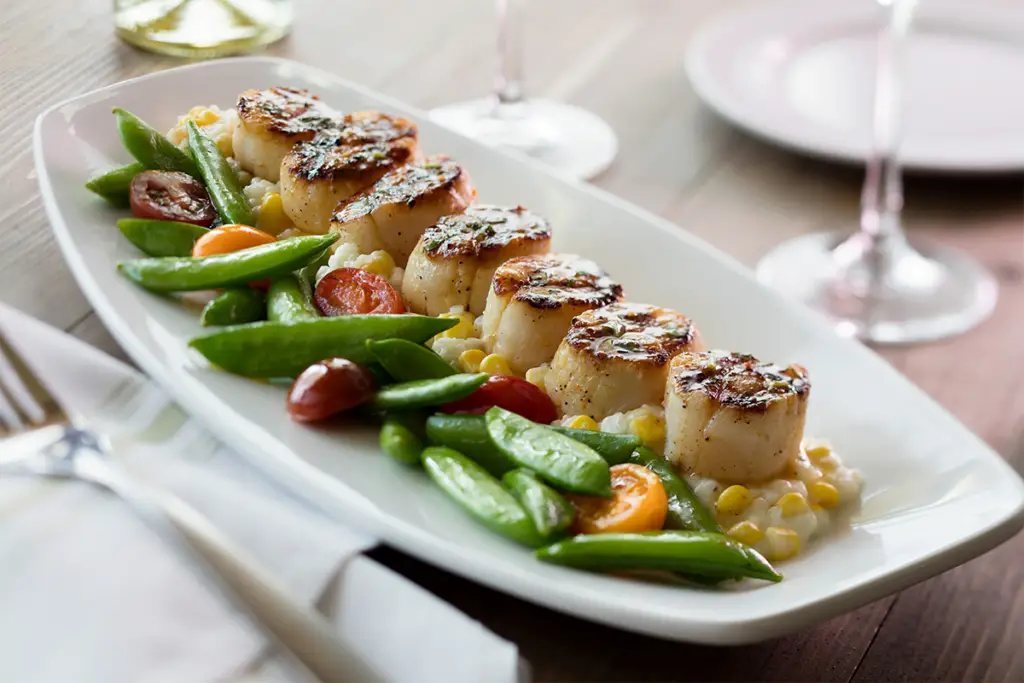
French cuisine—those two words evoke images of buttery croissants, velvety sauces, and decadent pastries. But beyond the indulgence lies a fascinating paradox: How can a nation renowned for its rich culinary heritage also maintain relatively good health? Let’s unravel this gastronomic enigma.
The French Way of Eating
Lifestyle, Not Diet
French eating isn’t a mere diet; it’s a lifestyle. It’s about savoring every bite, listening to your body, and celebrating food as an experience.
Vanessa Chalmé, a registered dietitian from France, emphasizes that the French way is intuitive—you feed not only your body but also your mind.
In-Season Produce
French tables overflow with in-season fruits and vegetables. These nutrient-rich foods are more satiating than highly processed alternatives.
The French prioritize fresh, local ingredients, which contribute to overall well-being.
Portion Control
French portions are modest. They focus on quality over quantity. Satiety comes from nutrient-dense foods, not super-sized servings.
The French Paradox
Wine and Heart Health
- The French love their red wine. Resveratrol, found in red wine, may protect against heart disease.
- Moderation is key—small glasses, not gallons.
Butter vs. Olive Oil
- Yes, French cuisine uses butter, but it’s balanced by olive oil.
- Olive oil’s monounsaturated fats promote heart health.
Cheese and Longevity
- French cheese consumption is high, yet France boasts longevity.
- Perhaps it’s the variety—Camembert, Roquefort, and Comté—each with unique health benefits.
The Not-So-Healthy Side
White Bread and Glycemic Index
- Baguettes are iconic, but white bread has a high glycemic index.
- It can increase the risk of weight gain, type 2 diabetes, and heart disease.
Processed Meats and Sodium
- French charcuterie—delicious but often high in sodium.
- Moderation matters.
The Changing Landscape
Fast Food Creeping In
- France’s love affair with fast food grows.
- Salt and processed ingredients pose health risks.
Healthy French Foods
- Not all French fare is indulgent.
- Scallops, for instance, are protein-rich and low-calorie, benefiting blood pressure and the nervous system4.
Conclusion: Savoir-Faire and Balance
French cuisine isn’t just about taste; it’s about savoir-faire—the art of living well. It’s about sipping wine, sharing laughter, and cherishing each meal. So, embrace the butter, but also reach for the olive oil. Savor the cheese, but balance it with fresh produce. And remember, health isn’t just what’s on your plate; it’s how you approach life.
Bon appétit, mes amis! 🥐🍷🧀
References
France’s National Dish
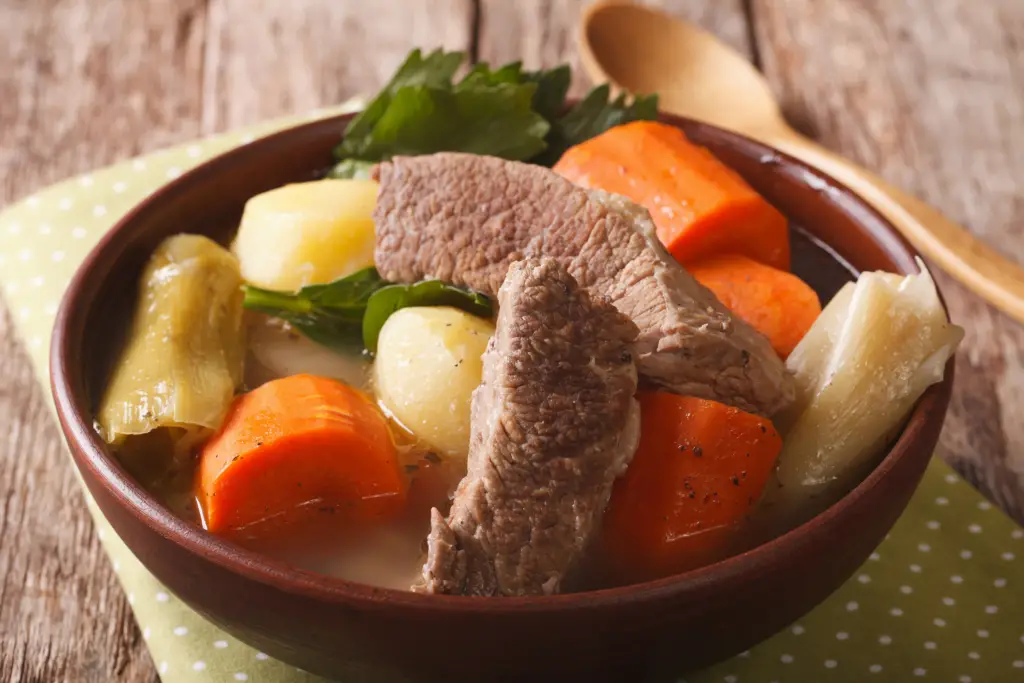
France doesn’t have an officially designated “national dish.” While there are many contenders with rich history and cultural significance, none hold the official title. This lack of a single “national dish” actually speaks to the incredible diversity and regional pride of French cuisine!
However, there are several strong contenders for the unofficial title, each with passionate advocates and delicious qualities:
Pot-au-feu
This hearty stew, featuring simmered beef, vegetables, and spices, is often considered the epitome of French comfort food. Its origins stretch back centuries, and it reflects the importance of local ingredients and slow cooking in traditional French cuisine.
Coq au vin
This Burgundy-based stew with rooster, vegetables, and wine is another classic, celebrated for its rich flavor and complex preparation. It showcases the French love for using red wine in cooking and the artistry of creating layered flavors through slow simmering.
Bouillabaisse
This vibrant seafood stew, originating in Provence, is a feast for the senses. Combining fresh fish, shellfish, and aromatic herbs in a saffron-infused broth, it reflects the bounty of the Mediterranean coast and the French appreciation for fresh, local ingredients.
Ratatouille
This colorful vegetable stew, showcasing tomatoes, eggplant, zucchini, and peppers, offers a lighter yet flavorful option. Its simplicity and reliance on fresh summer produce embody the principles of “cuisine minceur” (light cuisine) popularized in the 20th century.
Quiche Lorraine
This savory tart, featuring a flaky crust filled with custard, ham, and cheese, is a versatile and beloved dish. Its origins in the Lorraine region showcase the regional variations in French cuisine and the importance of local specialties.
While each of these dishes has its merits, ultimately, the “national dish” of France is a matter of personal preference and regional pride. Each region boasts its own specialties, reflecting the unique landscapes, ingredients, and culinary traditions that make French cuisine so diverse and delicious.
Classic French Recipes to Try at Home
One of the best ways to experience the flavors of French Cuisine is by trying your hand at cooking some classic French recipes. The following are some of our favorite recipes:
French Food – French Onion Soup

History and Background
French cuisine envelops us in a culinary embrace with the timeless Classic French Onion Soup. Originating from 18th-century France, this hearty soup emerged as a staple in French households. Its roots lie in the simple yet profound combination of caramelized onions, flavorful broth, and a melted cheese topping.
The dish not only warms the soul but also reflects the rustic elegance and rich culinary history of French cooking.
French Food – French Onion Soup Ingredients
- 4 large onions, thinly sliced
- 2 tablespoons butter
- 2 tablespoons olive oil
- 1 teaspoon sugar
- 2 cloves garlic, minced
- 1/2 cup dry white wine
- 8 cups beef broth
- 1 bay leaf
- Salt and pepper to taste
- Baguette slices
- 2 cups Gruyère cheese, grated
French Food – French Onion Soup Recipe
1. Caramelize the Onions
- In a large pot, melt butter with olive oil over medium heat.
- Add thinly sliced onions and sugar, stirring occasionally until the onions turn golden brown and caramelized.
2. Add Garlic and Wine
- Stir in minced garlic, cooking until fragrant.
- Pour in dry white wine, scraping the bottom of the pot to release any flavorful bits.
3. Simmer with Broth
- Add beef broth and a bay leaf to the pot.
- Season with salt and pepper to taste.
- Simmer the soup for 20-25 minutes, allowing the flavors to meld.
4. Toast the Baguette
- Preheat the oven broiler.
- Toast baguette slices until golden brown on both sides.
5. Assemble and Serve
- Ladle the hot soup into oven-safe bowls.
- Place a toasted baguette slice on top and generously sprinkle Gruyère cheese over it.
6. Broil to Perfection
- Place the bowls under the broiler until the cheese is melted and bubbly.
- Serve immediately, savoring the gooey goodness.
Serving: This recipe makes approximately 4 servings.
Cooking Time: Approximately 45 minutes
Nutritional Information (per serving):
- Calories: 450
- Protein: 15g
- Fat: 20g
- Carbohydrates: 45g
- Fiber: 5g
Embark on a culinary journey through French comfort with Classic French Onion Soup, a timeless dish that captures the essence of traditional French cooking!
French Food – Gougères (Cheese Puffs)

History and Background
French cuisine introduces us to the delectable world of Gougères, enchanting cheese puffs that trace their roots to the Burgundy region of France. Originating in the 17th century, these delightful bites were first created in the town of Yonne.
Gougères were initially served with local wines, and today, they stand as a testament to the rich heritage of French culinary craftsmanship. These airy, cheesy delights have become a staple in French households, capturing the hearts of those who crave the perfect balance of savory and light.
French Food – Gougères Ingredients
- 1 cup water
- 1/2 cup unsalted butter
- 1 cup all-purpose flour
- 4 large eggs
- 1 1/2 cups Gruyère cheese, grated
- 1/2 teaspoon salt
- 1/4 teaspoon black pepper
- Pinch of nutmeg
French Food – Gougères Recipe
1. Prepare the Dough
- In a saucepan, bring water and butter to a simmer over medium heat.
- Add flour and stir vigorously until the mixture forms a smooth dough.
2. Add Eggs and Cheese
- Remove the saucepan from heat and let it cool slightly.
- Beat in the eggs one at a time, ensuring each is fully incorporated.
- Fold in the grated Gruyère cheese, salt, black pepper, and a pinch of nutmeg.
3. Form and Bake
- Preheat the oven to 425°F (220°C).
- Drop spoonfulls of the dough onto a baking sheet, leaving space between each puff.
- Bake for 15-20 minutes or until the Gougères are golden brown and puffed.
4. Serve Warm
- Allow the Gougères to cool slightly before serving.
- Serve these cheesy delights warm, savoring the airy texture and rich flavor.
Serving: This recipe makes approximately 24 Gougères, serving 6-8 people.
Cooking Time: Approximately 30 minutes
Nutritional Information (per serving):
- Calories: 180
- Protein: 6g
- Fat: 14g
- Carbohydrates: 7g
- Fiber: 1g
Indulge in the elegance of French cuisine with Gougères, an irresistible blend of cheesy goodness and delicate puff pastry!
French Food – Steak Frites

History and Background
French cuisine invites us to indulge in the timeless delight of Steak Frites, a beloved classic that emerged from the bistros of Paris. Originating in the 19th century, this iconic dish represents the epitome of French comfort food.
The simplicity of a perfectly cooked steak paired with golden, crispy fries mirrors the rustic elegance of French culinary traditions. As you savor each bite, you’re transported to the bustling streets and charming cafes of France, where Steak Frites is not just a meal but an experience.
French Food – Steak Frites Ingredients
For the Steak:
- 4 beef sirloin steaks (6-8 oz each)
- Salt and black pepper to taste
- 2 tablespoons olive oil
- 2 tablespoons unsalted butter
- 2 cloves garlic, minced
- Fresh herbs for garnish (optional)
For the Frites:
- 4 large russet potatoes, peeled and cut into fries
- Vegetable oil for frying
- Salt to taste
French Food – Steak Frites Recipe
Prepare the Steak
- Season the Steaks:
- Pat the steaks dry and season both sides with salt and black pepper.
- Sear the Steaks:
- Heat olive oil in a skillet over medium-high heat.
- Sear the steaks for 3-4 minutes per side for medium-rare, adjusting the time for desired doneness.
- Add butter and minced garlic to the pan, basting the steaks with the flavorful mixture.
- Rest and Garnish:
- Allow the steaks to rest for a few minutes before slicing.
- Garnish with fresh herbs if desired.
Make the Frites
- Prep the Potatoes:
- Cut peeled potatoes into even-sized fries.
- Preheat the Oil:
- Heat vegetable oil in a deep fryer or large pot to 350°F (175°C).
- Fry the Potatoes:
- Fry the potatoes in batches until golden brown, about 3-4 minutes per batch.
- Remove and drain on paper towels, then sprinkle with salt.
Serve and Enjoy
- Plate the Dish:
- Arrange the sliced steak on a plate.
- Serve alongside a generous portion of golden Frites.
- Savor the Experience:
- Dive into the succulent steak and crisp, flavorful fries, savoring the classic French harmony on your palate.
Serving: This recipe serves 4 people.
Cooking Time: Approximately 30 minutes
Nutritional Information (per serving):
- Calories: 650 (Steak), 300 (Frites)
- Protein: 35g (Steak), 4g (Frites)
- Fat: 50g (Steak), 15g (Frites)
- Carbohydrates: 10g (Steak), 30g (Frites)
Indulge in the culinary romance of France with Steak Frites, a dish that transcends time and captures the essence of French gastronomy!
French Food – Crêpes

History and Background
French cuisine unfolds its delicate charm with Classic Crêpes, a culinary masterpiece with roots tracing back to Brittany, France. Originating in the 13th century, these thin, delectable pancakes were initially made with buckwheat flour.
Over time, crêpes evolved into a versatile treat enjoyed throughout France and beyond. Whether filled with sweet jams or savory delights, crêpes reflect the artistry and finesse that define French culinary culture.
French Food – Crêpes Ingredients
- 1 cup all-purpose flour
- 2 eggs
- 1 1/2 cups whole milk
- 2 tablespoons unsalted butter, melted
- 1 tablespoon sugar (for sweet crêpes)
- Pinch of salt
- Additional butter for cooking
Sweet Crêpes:
- Nutella
- Fresh berries
- Powdered sugar
Savory Crêpes:
- Ham
- Swiss cheese
- Spinach
- Béchamel sauce
French Food – Crêpes Recipe
Prepare the Crêpe Batter
- Combine Ingredients:
- In a blender, blend flour, eggs, milk, melted butter, sugar (for sweet crêpes), and a pinch of salt until smooth.
- Rest the Batter:
- Allow the batter to rest for at least 30 minutes. This step enhances the texture of the crêpes.
Cook the Crêpes
- Heat the Pan:
- Heat a non-stick skillet or crêpe pan over medium heat.
- Coat with Butter:
- Add a small amount of butter to coat the pan evenly.
- Pour and Swirl:
- Pour a small amount of batter into the center of the pan, swirling it to spread thinly.
- Cook Both Sides:
- Cook for about 1-2 minutes until the edges start to lift, then flip and cook the other side.
- Repeat:
- Repeat the process with the remaining batter, stacking the cooked crêpes on a plate.
Fill and Serve
- For Sweet Crêpes:
- Spread Nutella on the crêpe, add fresh berries, fold, and dust with powdered sugar.
- For Savory Crêpes:
- Layer ham, Swiss cheese, and spinach on the crêpe, fold, and drizzle with béchamel sauce.
Enjoy the Delight
- Serve Warm:
- Serve the crêpes warm, savoring the delicate flavors and customizable fillings.
Serving: This recipe makes approximately 12 crêpes, serving 4-6 people.
Cooking Time: Approximately 30 minutes
Nutritional Information (per serving):
- Calories: 120 (per crêpe)
- Protein: 4g
- Fat: 6g
- Carbohydrates: 12g
- Fiber: 0.5g
Elevate your taste buds with the elegance of French cuisine through Classic Crêpes, a delightful canvas for both sweet and savory creations!
French Food – Blood Orange & Dark Chocolate Madeleines

History and Background
French cuisine takes a sweet turn with Blood Orange & Dark Chocolate Madeleines, a delightful treat that melds tradition with innovation. The iconic madeleine traces its origins to the town of Commercy in northeastern France. Originally created in the 18th century, these small, shell-shaped sponge cakes have become synonymous with French patisserie.
This modern twist, featuring the vibrant flavors of blood orange and rich dark chocolate, pays homage to the timeless allure of French baking.
French Food – Blood Orange & Dark Chocolate Madeleines Ingredients
- 2/3 cup all-purpose flour
- 1/2 cup granulated sugar
- 1/4 cup unsalted butter, melted
- 2 large eggs
- 1 teaspoon baking powder
- Zest of 1 blood orange
- 2 tablespoons blood orange juice
- 1/4 cup dark chocolate, chopped
- Pinch of salt
- Powdered sugar for dusting
French Food – Blood Orange & Dark Chocolate Madeleines Recipe
Prepare the Batter
- Combine Dry Ingredients:
- In a bowl, whisk together flour, baking powder, and a pinch of salt.
- Whisk Sugar and Eggs:
- In another bowl, whisk sugar and eggs until light and fluffy.
- Add Melted Butter:
- Gradually add melted butter to the sugar and egg mixture, whisking continuously.
- Fold in Dry Ingredients:
- Gently fold in the dry ingredients until just combined.
Infuse Blood Orange Flavor
- Zest and Juice:
- Zest one blood orange and add it to the batter.
- Squeeze 2 tablespoons of blood orange juice into the batter.
- Mix in Chocolate:
- Fold in chopped dark chocolate, ensuring an even distribution.
Chill and Preheat Oven
- Chill the Batter:
- Cover the batter and chill in the refrigerator for at least 1 hour.
- Preheat the Oven:
- Preheat the oven to 375°F (190°C) and grease madeleine molds.
Bake the Madeleines
- Fill the Molds:
- Spoon the chilled batter into the madeleine molds, filling each about 3/4 full.
- Bake:
- Bake for 10-12 minutes or until the edges are golden brown and the centers spring back.
- Cool and Dust:
- Allow the madeleines to cool slightly before transferring to a wire rack.
- Dust with powdered sugar before serving.
Serving: This recipe makes approximately 24 madeleines, serving 6-8 people.
Cooking Time: Approximately 15 minutes
Nutritional Information (per serving – 3 madeleines):
- Calories: 180
- Protein: 3g
- Fat: 9g
- Carbohydrates: 22g
- Fiber: 1g
Embark on a journey of sweet indulgence with Blood Orange & Dark Chocolate Madeleines, a modern twist on a French classic!
French Food – Potatoes Au Gratin

History and Background
French cuisine unfolds a dish of creamy decadence with Potatoes Au Gratin. Originating in the Dauphiné region of France, this gratin, also known as Dauphinois, pays homage to the culinary creativity of the French Alps.
Traditionally made with thinly sliced potatoes, cream, and cheese, this dish emerged as a comforting staple in French households. Its layered perfection and rich flavors have made it a timeless classic, inviting us to savor the warmth and simplicity of French home cooking.
French Food – Potatoes Au Gratin Ingredients
- 4 large russet potatoes, peeled and thinly sliced
- 2 cups heavy cream
- 1 cup whole milk
- 2 cups Gruyère cheese, grated
- 1 cup Parmesan cheese, grated
- 2 cloves garlic, minced
- Salt and pepper to taste
- 1/4 teaspoon ground nutmeg
- 2 tablespoons unsalted butter, for greasing
French Food – Potatoes Au Gratin Recipe
Prepare the Potatoes
- Slice the Potatoes:
- Peel and thinly slice the russet potatoes.
- Preheat Oven:
- Preheat the oven to 375°F (190°C).
Make the Cream Mixture
- Combine Cream and Milk:
- In a bowl, mix together heavy cream and whole milk.
- Add Garlic and Seasonings:
- Stir in minced garlic, salt, pepper, and ground nutmeg.
Layer the Potatoes
- Grease the Dish:
- Butter the bottom and sides of a baking dish.
- Layer Potatoes and Cheese:
- Arrange a layer of sliced potatoes in the dish.
- Sprinkle a portion of Gruyère and Parmesan cheese over the potatoes.
- Repeat the layers until all potatoes and cheese are used.
Pour the Cream Mixture
- Pour Over Potatoes:
- Pour the cream and milk mixture evenly over the layered potatoes and cheese.
Bake to Perfection
- Cover and Bake:
- Cover the baking dish with foil and bake for 45 minutes.
- Uncover and Brown:
- Uncover the dish and bake for an additional 15-20 minutes or until the top is golden brown.
Serve and Enjoy
- Rest Before Serving:
- Allow the Potatoes Au Gratin to rest for a few minutes before serving.
- Serve Warm:
- Serve this creamy delight warm, enjoying the layers of cheesy goodness.
Serving: This recipe serves approximately 6 people.
Cooking Time: Approximately 1 hour
Nutritional Information (per serving):
- Calories: 450
- Protein: 15g
- Fat: 30g
- Carbohydrates: 35g
- Fiber: 3g
Delight in the lusciousness of French comfort with Potatoes Au Gratin, a dish that invites you to experience the heartwarming essence of French Alps cuisine!
French Food – Chocolate Soufflé

History and Background
French cuisine dazzles our taste buds with the exquisite Chocolate Soufflé, a dessert that epitomizes the artistry of French patisserie. Originating in 18th-century France, the soufflé has become a symbol of sophistication and indulgence. Hailing from the culinary capital of the world, Paris, this dessert is crafted with a blend of elegance and precision.
The soufflé’s airy texture and rich chocolate flavor have made it a timeless favorite in both French bistros and fine dining establishments.
French Food – Chocolate Soufflé Ingredients
- 1/2 cup unsalted butter, plus extra for coating ramekins
- 1/3 cup all-purpose flour
- 1 cup whole milk
- 1 cup dark chocolate, chopped
- 4 large eggs, separated
- 1/2 cup granulated sugar, plus extra for coating ramekins
- 1 teaspoon vanilla extract
- Pinch of salt
- Powdered sugar for dusting (optional)
French Food – Chocolate Soufflé Recipe
Prepare the Soufflé Base
- Butter and Sugar Ramekins:
- Butter the insides of the ramekins and coat with granulated sugar, tapping out the excess.
- Make Roux:
- In a saucepan, melt 1/2 cup of butter over medium heat.
- Stir in flour to create a smooth roux.
- Add Milk and Chocolate:
- Gradually whisk in the milk, ensuring no lumps.
- Add the chopped dark chocolate, stirring until melted and smooth.
Whip Egg Whites
- Separate Eggs:
- Separate egg whites and yolks, placing whites in a clean, dry bowl.
- Whip Egg Whites:
- Using an electric mixer, beat egg whites until soft peaks form.
- Add Sugar and Vanilla:
- Gradually add 1/2 cup of granulated sugar while continuing to beat.
- Add vanilla extract and a pinch of salt.
Combine and Bake
- Fold Ingredients:
- Gently fold the egg yolk-chocolate mixture into the whipped egg whites until just combined.
- Fill Ramekins:
- Spoon the soufflé mixture into the prepared ramekins, filling almost to the top.
- Bake:
- Bake in a preheated oven at 375°F (190°C) for 18-20 minutes or until the tops are set and risen.
Serve and Enjoy
- Dust with Powdered Sugar:
- If desired, dust the tops with powdered sugar before serving.
- Serve Immediately:
- Serve the Chocolate Soufflés immediately, savoring the velvety texture and rich chocolate flavor.
Serving: This recipe makes 4 individual soufflés.
Cooking Time: Approximately 30 minutes
Nutritional Information (per serving):
- Calories: 420
- Protein: 8g
- Fat: 30g
- Carbohydrates: 35g
- Fiber: 2g
Experience the magic of French dessert with the Chocolate Soufflé, a showstopper that captures the essence of Parisian indulgence!
French Food – Baked Brie in Puff Pastry

History and Background
French cuisine invites us into the realm of decadence with Baked Brie in Puff Pastry, a dish that embodies the sophistication of French appetizers. While the exact origins remain elusive, the use of Brie, a soft and creamy French cheese, dates back to the 8th century.
Pairing it with flaky puff pastry elevates the experience, creating a harmonious blend of textures and flavors. This appetizer captures the essence of French culinary finesse and has become a staple in both casual gatherings and upscale events.
French Food – Baked Brie in Puff Pastry Ingredients
- 1 wheel of Brie cheese (about 8 ounces)
- 1 sheet puff pastry, thawed
- 1/4 cup fruit preserves (apricot, raspberry, or fig)
- 1 egg, beaten (for egg wash)
- 1 tablespoon honey (optional)
- Crackers or bread for serving
French Food – Baked Brie in Puff Pastry Recipe
Prepare the Brie
- Preheat Oven:
- Preheat the oven to 400°F (200°C).
- Wrap Brie in Puff Pastry:
- Roll out the puff pastry sheet on a lightly floured surface.
- Place the Brie wheel in the center and spread fruit preserves on top.
- Encase in Pastry:
- Fold the pastry over the Brie, sealing the edges.
- Trim any excess pastry for a neat appearance.
Bake to Perfection
- Brush with Egg Wash:
- Brush the puff pastry with the beaten egg for a golden finish.
- Bake:
- Place the wrapped Brie on a baking sheet and bake for 20-25 minutes or until the pastry is golden brown.
Serve and Garnish
- Drizzle with Honey:
- Optional: Drizzle honey over the baked Brie for a touch of sweetness.
- Garnish:
- Garnish with fresh herbs or additional fruit preserves.
Enjoy the Melty Goodness
- Serve Warm:
- Allow the Baked Brie to cool slightly before serving.
- Serve with crackers or bread, savoring the gooey Brie and flaky puff pastry.
Serving: This appetizer serves approximately 6-8 people.
Cooking Time: Approximately 25 minutes
Nutritional Information (per serving):
- Calories: 250
- Protein: 8g
- Fat: 15g
- Carbohydrates: 20g
- Fiber: 1g
Indulge in the lusciousness of French elegance with Baked Brie in Puff Pastry, a delightful prelude to a sumptuous culinary journey!
French Food – Lyonnaise Potatoes

History and Background
French cuisine welcomes us to the comforting heart of Lyon with Lyonnaise Potatoes, a dish that captures the essence of rustic simplicity. Originating from the Rhône-Alpes region in eastern France, Lyonnaise Potatoes showcase the culinary prowess of Lyon, a city renowned for its bouchons and traditional French fare.
This side dish, marrying sautéed potatoes with sweet onions and fresh herbs, epitomizes the warmth and charm of French home cooking.
French Food – Lyonnaise Potatoes Ingredients
- 4 large russet potatoes, peeled and thinly sliced
- 2 large onions, thinly sliced
- 4 tablespoons unsalted butter
- 2 tablespoons olive oil
- Salt and pepper to taste
- 2 tablespoons fresh parsley, chopped
French Food – Lyonnaise Potatoes Recipe
Prepare Potatoes and Onions
- Slice Potatoes and Onions:
- Peel and thinly slice the russet potatoes and onions.
- Sauté Potatoes:
- In a large skillet, heat 2 tablespoons of butter and 1 tablespoon of olive oil.
- Add the sliced potatoes and sauté until golden brown and cooked through.
- Caramelize Onions:
- In another skillet, heat the remaining butter and olive oil.
- Add the sliced onions and sauté until caramelized and golden.
Combine and Season
- Merge Potatoes and Onions:
- Combine the sautéed potatoes and caramelized onions in one skillet.
- Season to Perfection:
- Season with salt and pepper to taste, ensuring an even distribution.
Garnish and Serve Warm
- Sprinkle Fresh Parsley:
- Sprinkle chopped fresh parsley over the Lyonnaise Potatoes for a burst of flavor.
- Serve Warm:
- Serve the dish warm, savoring the harmonious blend of textures and flavors.
Serving: This recipe serves approximately 4-6 people as a delightful side dish.
Cooking Time: Approximately 30 minutes
Nutritional Information (per serving):
- Calories: 250
- Protein: 3g
- Fat: 12g
- Carbohydrates: 35g
- Fiber: 4g
Delight in the warmth of French culinary traditions with Lyonnaise Potatoes, a dish that transports you to the cozy kitchens of Lyon!
French Food – French Apple Tart

History and Background
French cuisine unveils the exquisite charm of the French Apple Tart, a dessert that epitomizes the artistry of French patisserie. Rooted in the rich agricultural traditions of Normandy and Brittany, this classic tart pays homage to the abundance of apples in the region.
The marriage of buttery pastry, thinly sliced apples, and a glossy apricot glaze creates a symphony of flavors that captures the essence of French pastry-making, dating back to the 17th century.
French Food – French Apple Tart Ingredients
- 1 sheet puff pastry, thawed
- 4-5 medium-sized apples (Granny Smith or Honeycrisp)
- 1/4 cup apricot jam
- 2 tablespoons unsalted butter, melted
- 2 tablespoons granulated sugar
- 1/2 teaspoon ground cinnamon
- Powdered sugar for dusting (optional)
French Food – French Apple Tart Recipe
Prepare the Puff Pastry Base
- Preheat Oven:
- Preheat the oven to 400°F (200°C).
- Roll Out Puff Pastry:
- Roll out the puff pastry sheet on a lightly floured surface to form a rectangular shape.
- Create Pastry Border:
- Score a border about 1 inch from the edges of the pastry, without cutting through.
Apple Filling
- Slice Apples Thinly:
- Peel, core, and thinly slice the apples.
- Arrange Apple Slices:
- Arrange the apple slices within the scored border on the puff pastry.
- Brush with Butter and Sugar:
- Brush the apple slices with melted butter and sprinkle granulated sugar over them.
- Dust with Cinnamon:
- Dust the apples with ground cinnamon for a warm and aromatic touch.
Bake to Perfection
- Bake in Preheated Oven:
- Place the prepared French Apple Tart in the preheated oven and bake for 20-25 minutes or until the pastry is golden brown.
Glaze and Serve
- Apricot Glaze:
- In a small saucepan, heat apricot jam until melted. Strain to remove solids.
- Brush with Apricot Glaze:
- Brush the melted apricot jam over the baked tart for a glossy finish.
Serve and Enjoy
- Dust with Powdered Sugar:
- Optional: Dust the tart with powdered sugar before serving.
- Serve Warm or at Room Temperature:
- Serve slices of the French Apple Tart warm or at room temperature.
Serving: This dessert serves approximately 6-8 people.
Cooking Time: Approximately 25 minutes
Nutritional Information (per serving):
- Calories: 220
- Protein: 2g
- Fat: 10g
- Carbohydrates: 32g
- Fiber: 3g
Indulge in the timeless allure of French patisserie with the French Apple Tart, a delightful journey into the heart of French culinary artistry!
French Food – French Macarons

History and Background
French cuisine whispers tales of delicate indulgence through the enchanting French Macarons. Originating in Italy during the Renaissance, these colorful almond meringue cookies found their fame in 18th-century France.
The French embraced and refined the macaron, turning it into a symbol of sophistication. Known for their airy shells and luscious fillings, French Macarons have become a beloved treat in patisseries worldwide.
French Food – French Macarons Ingredients
- 1 cup almond flour
- 1 3/4 cups confectioners’ sugar
- 3 large egg whites, at room temperature
- 1/4 cup granulated sugar
- 1/2 teaspoon vanilla extract
- Food coloring (optional)
For the Filling:
- 1/2 cup unsalted butter, softened
- 1 cup confectioners’ sugar
- 1 teaspoon vanilla extract
- Jam, ganache, or lemon curd for flavor (optional)
French Food – French Macarons Recipe
Prepare the Almond Meringue Batter
- Sift Almond Flour and Confectioners’ Sugar:
- In a bowl, sift together almond flour and confectioners’ sugar to remove lumps.
- Whip Egg Whites:
- In a separate bowl, whip egg whites until soft peaks form.
- Gradually add granulated sugar while whipping until stiff peaks form.
- Fold Dry Ingredients:
- Gently fold the sifted almond flour mixture into the whipped egg whites.
- Add Vanilla and Food Coloring:
- Stir in vanilla extract and add food coloring if desired.
Pipe and Rest the Macarons
- Pipe Batter onto Baking Sheets:
- Line baking sheets with parchment paper.
- Pipe small circles of batter onto the sheets.
- Rest and Form a Skin:
- Let the piped macarons rest for 30 minutes to 1 hour, allowing a skin to form.
Bake and Cool
- Preheat and Bake:
- Preheat the oven to 300°F (150°C).
- Bake the macarons for 15-18 minutes.
- Cool Completely:
- Allow the baked macarons to cool completely before filling.
Prepare the Filling and Assemble
- Make Buttercream Filling:
- In a bowl, beat softened butter until creamy.
- Add confectioners’ sugar and vanilla extract, beating until smooth.
- Fill the Macarons:
- Pair similar-sized macaron shells and pipe or spread filling on one half.
- Sandwich with the other half, creating a delightful macaron.
Serve and Enjoy
- Refrigerate Before Serving:
- For best results, refrigerate the filled macarons for 24 hours before serving.
- Serve and Indulge:
- Serve these French Macarons chilled and indulge in their delicate, melt-in-your-mouth perfection.
Serving: This recipe makes approximately 24 filled macarons.
Cooking Time: Approximately 18 minutes
Nutritional Information (per serving – 2 macarons):
- Calories: 120
- Protein: 2g
- Fat: 7g
- Carbohydrates: 13g
- Sugar: 12g
Embark on a sweet journey with French Macarons, a delightful creation that transports you to the heart of French patisserie sophistication!
French Food – Chicken Fricassee

History and Background
French cuisine enchants us with the timeless allure of Chicken Fricassee, a classic comfort dish rooted in French culinary history. Originating in the 16th century, the term “fricassee” refers to a cooking method involving sautéing meat and then stewing it in a flavorful sauce.
This dish showcases the essence of French home cooking, blending tender chicken with aromatic herbs, mushrooms, and a velvety white sauce. A true celebration of French gastronomy, Chicken Fricassee has stood the test of time as a beloved family meal.
French Food – Chicken Fricassee Ingredients
- 2.5 to 3 pounds chicken pieces (whole chicken, thighs, or drumsticks)
- Salt and pepper to taste
- 2 tablespoons olive oil
- 1 onion, finely chopped
- 2 carrots, peeled and sliced
- 2 cloves garlic, minced
- 1/4 cup all-purpose flour
- 1 cup dry white wine
- 2 cups chicken broth
- 1 bouquet garni (a bundle of herbs tied together with kitchen twine)
- 1 cup button mushrooms, sliced
- 1 cup frozen pearl onions, thawed
- 1/2 cup heavy cream
- Chopped fresh parsley for garnish
French Food – Chicken Fricassee Recipe
Season and Sear the Chicken
- Season Chicken:
- Season chicken pieces with salt and pepper.
- Sear Chicken:
- In a large Dutch oven, heat olive oil over medium-high heat.
- Sear the chicken pieces until golden brown on all sides.
Prepare Aromatic Vegetables and Make Roux
- Sauté Onion, Carrots, and Garlic:
- Add chopped onion, sliced carrots, and minced garlic to the Dutch oven. Sauté until softened.
- Add Flour to Make Roux:
- Sprinkle flour over the vegetables and stir to create a roux.
Deglaze and Simmer
- Deglaze with White Wine:
- Pour in the dry white wine, scraping up any browned bits from the bottom of the pot.
- Add Chicken Broth and Bouquet Garni:
- Pour in chicken broth and add the bouquet garni.
- Bring the mixture to a simmer, then reduce heat.
Simmer Chicken with Vegetables and Mushrooms
- Add Chicken Back to Pot:
- Return the seared chicken to the pot.
- Add Mushrooms and Pearl Onions:
- Stir in sliced mushrooms and thawed pearl onions.
- Simmer Until Chicken is Cooked:
- Simmer the mixture, covered, until the chicken is cooked through.
Finish with Cream and Garnish
- Stir in Heavy Cream:
- Pour in the heavy cream and stir until the sauce is creamy.
- Garnish and Serve:
- Garnish with chopped fresh parsley before serving.
Serving: This recipe serves approximately 4-6 people.
Cooking Time: Approximately 1 hour
Nutritional Information (per serving):
- Calories: 400
- Protein: 30g
- Fat: 25g
- Carbohydrates: 10g
- Fiber: 2g
Dive into the heartwarming flavors of French tradition with Chicken Fricassee, a dish that embodies the soul of French countryside cooking!
French Food – Chicken Roulade Stuffed with Brussels Sprouts, Walnuts, and Pecorino

History and Background
French cuisine takes a delightful twist with Chicken Roulade Stuffed with Brussels Sprouts, Walnuts, and Pecorino. While traditional French roulades are known for their elegance, this dish infuses a modern twist by combining classic French techniques with a fusion of flavors.
Originating from the inventive kitchens of contemporary French culinary artists, this roulade pays homage to the diverse and dynamic nature of French gastronomy.
French Food – Chicken Roulade Stuffed with Brussels Sprouts, Walnuts, and Pecorino Ingredients
- 2 boneless, skinless chicken breasts
- 1 cup Brussels sprouts, finely shredded
- 1/2 cup walnuts, chopped
- 1/2 cup Pecorino cheese, grated
- 2 tablespoons olive oil
- Salt and pepper to taste
- 1 teaspoon dried thyme
- 1 teaspoon garlic powder
- 1 cup chicken broth
- 2 tablespoons butter
- Fresh parsley for garnish (optional)
French Food – Chicken Roulade Stuffed with Brussels Sprouts, Walnuts, and Pecorino Recipe
Prepare Chicken and Filling
- Flatten Chicken Breasts:
- Place chicken breasts between plastic wrap and gently pound to an even thickness.
- Season Chicken:
- Season chicken breasts with salt, pepper, dried thyme, and garlic powder.
Create Filling Mixture
- Prepare Brussels Sprouts:
- Shred Brussels sprouts finely and mix them with chopped walnuts and grated Pecorino.
- Sauté Filling:
- In a skillet, sauté the Brussels sprouts mixture in olive oil until slightly softened.
Assemble and Roll
- Fill and Roll Chicken:
- Spread the Brussels sprouts mixture over the chicken breasts and roll them tightly.
- Secure with Twine:
- Secure the roulades with kitchen twine at regular intervals.
Sear and Roast
- Sear Roulades:
- In an ovenproof skillet, sear the roulades on all sides until golden brown.
- Roast in Oven:
- Transfer the skillet to a preheated oven and roast the roulades at 375°F (190°C) for 25-30 minutes.
Make Pan Sauce and Serve
- Deglaze with Broth:
- Deglaze the skillet with chicken broth, scraping up any flavorful bits.
- Finish with Butter:
- Finish the pan sauce with butter for a rich and glossy texture.
- Slice and Garnish:
- Slice the Chicken Roulade and serve drizzled with pan sauce. Garnish with fresh parsley if desired.
Serving: This recipe serves approximately 2-3 people.
Cooking Time: Approximately 45 minutes
Nutritional Information (per serving):
- Calories: 450
- Protein: 30g
- Fat: 32g
- Carbohydrates: 10g
- Fiber: 3g
Delight in the harmonious blend of textures and flavors with Chicken Roulade Stuffed with Brussels Sprouts, Walnuts, and Pecorino – a French fusion masterpiece!
French Food – Vegan French Onion Stew

History and Background
French cuisine embraces plant-based elegance with Vegan French Onion Stew. Rooted in the rich culinary traditions of French onion soup, this vegan adaptation captures the essence of comfort and flavor without relying on animal products.
Originating from the rustic kitchens of France, this stew showcases the aromatic allure of caramelized onions, simmered to perfection in a savory broth. A celebration of plant-based indulgence, Vegan French Onion Stew beautifully marries tradition and compassion.
French Food – Vegan French Onion Stew Ingredients
- 4 large yellow onions, thinly sliced
- 2 tablespoons olive oil
- 2 cloves garlic, minced
- 1 teaspoon dried thyme
- 1 bay leaf
- 1/2 cup dry white wine
- 6 cups vegetable broth
- Salt and pepper to taste
- Baguette slices (for serving)
- Vegan cheese, grated (for serving)
French Food – Vegan French Onion Stew Recipe
Caramelize Onions
- Thinly Slice Onions:
- Peel and thinly slice the yellow onions.
- Sauté Onions:
- In a large pot, heat olive oil over medium heat.
- Add sliced onions and sauté until caramelized, stirring occasionally.
Infuse Flavor
- Add Garlic and Thyme:
- Stir in minced garlic and dried thyme, allowing the flavors to meld.
- Deglaze with White Wine:
- Pour in the dry white wine to deglaze the pot, scraping up any flavorful bits.
Simmer to Perfection
- Pour in Vegetable Broth:
- Add vegetable broth to the pot, stirring well.
- Add Bay Leaf:
- Toss in the bay leaf for a subtle herbal essence.
- Season and Simmer:
- Season the stew with salt and pepper to taste.
- Simmer on low heat for 30-40 minutes to allow flavors to develop.
Serve and Enjoy
- Toast Baguette Slices:
- Toast baguette slices until golden brown.
- Ladle Stew into Bowls:
- Remove the bay leaf and ladle the Vegan French Onion Stew into serving bowls.
- Top with Baguette and Vegan Cheese:
- Float a slice of toasted baguette on top and generously sprinkle with grated vegan cheese.
Serving: This recipe serves approximately 4-6 people.
Cooking Time: Approximately 40 minutes
Nutritional Information (per serving):
- Calories: 220
- Protein: 3g
- Fat: 8g
- Carbohydrates: 30g
- Fiber: 5g
Savor the goodness of Vegan French Onion Stew, a compassionate twist on a French classic that warms both the heart and soul!
French Food – Classic French Bread

History and Background
French cuisine unfolds a timeless tale of culinary artistry with Classic French Bread, known as “Baguette” in its iconic slender form. Originating in the 18th century, this bread is deeply embedded in French culture.
Crafted with simplicity yet demanding precision, the baguette symbolizes the essence of French baking. Traditionally enjoyed fresh from local boulangeries, it has become a staple at French tables worldwide.
French Food – Classic French Bread Ingredients
- 4 cups bread flour
- 2 teaspoons active dry yeast
- 1 1/2 teaspoons salt
- 1 1/2 cups warm water
French Food – Classic French Bread Recipe
Prepare the Dough
- Activate Yeast:
- In a bowl, combine warm water and active dry yeast. Let it sit for 5 minutes until frothy.
- Mix Flour and Salt:
- In a large mixing bowl, combine bread flour and salt.
- Combine Wet and Dry Ingredients:
- Pour the yeast mixture into the flour mixture, stirring until a dough forms.
Knead and Rise
- Knead the Dough:
- Transfer the dough to a floured surface and knead for about 10 minutes until smooth.
- First Rise:
- Place the dough in a greased bowl, cover it, and let it rise in a warm place for 1-2 hours until doubled in size.
Shape and Second Rise
- Divide and Shape:
- Divide the dough into two equal portions and shape each into a baguette.
- Second Rise:
- Place the shaped baguettes on a baking sheet, cover, and let them rise for another 30-45 minutes.
Bake to Perfection
- Preheat and Score:
- Preheat the oven to 450°F (230°C). Score the tops of the baguettes with a sharp knife.
- Bake:
- Bake the baguettes for 20-25 minutes until golden brown and crisp.
Cool and Enjoy
- Cool on Wire Rack:
- Allow the baguettes to cool on a wire rack for at least 15 minutes.
- Slice and Serve:
- Slice the Classic French Bread and serve it fresh with your favorite toppings.
Serving: This recipe makes two baguettes and serves approximately 8-10 people.
Cooking Time: Approximately 25 minutes
Nutritional Information (per serving – 1 slice):
- Calories: 120
- Protein: 3g
- Fat: 0g
- Carbohydrates: 25g
- Fiber: 1g
Embrace the magic of Classic French Bread, a culinary masterpiece that encapsulates the essence of French baking traditions!
French Food – Fondant Potatoes

History and Background
French cuisine brings us the epitome of indulgence with Fondant Potatoes. Originating in the 19th century, these decadent potatoes exemplify the rich culinary heritage of French gastronomy.
Hailing from the Haute Cuisine era, Fondant Potatoes showcase the meticulous art of cooking, transforming humble spuds into a symphony of flavors and textures. Rooted in classic French techniques, this dish pays homage to the sophistication of French culinary history.
French Food – Fondant Potatoes Ingredients
- 4 large russet potatoes, peeled and cut into cylinders
- 1/4 cup unsalted butter
- 1 cup chicken or vegetable broth
- 2 cloves garlic, minced
- 2 sprigs fresh thyme
- Salt and pepper to taste
- Chopped fresh parsley for garnish (optional)
French Food – Fondant Potatoes Recipe
Prepare Potatoes
- Peel and Cut Potatoes:
- Peel the potatoes and cut them into cylindrical shapes.
- Preheat Oven:
- Preheat the oven to 400°F (200°C).
Sear and Infuse Flavor
- Sear Potatoes:
- In an ovenproof skillet, melt butter over medium-high heat.
- Sear the potatoes until golden brown on all sides.
- Add Garlic and Thyme:
- Add minced garlic and fresh thyme sprigs to infuse flavor.
Bake with Broth
- Pour Broth Over Potatoes:
- Pour chicken or vegetable broth over the potatoes in the skillet.
- Season with Salt and Pepper:
- Season with salt and pepper to taste.
- Bake in Oven:
- Transfer the skillet to the preheated oven and bake for 30-40 minutes until potatoes are tender.
Baste and Serve
- Baste Potatoes:
- Baste the potatoes with the broth halfway through the baking time.
- Garnish and Serve:
- Garnish with chopped fresh parsley if desired and serve the Fondant Potatoes hot.
Serving: This recipe serves approximately 4 people.
Cooking Time: Approximately 40 minutes
Nutritional Information (per serving):
- Calories: 250
- Protein: 3g
- Fat: 12g
- Carbohydrates: 35g
- Fiber: 3g
Indulge in the luxurious simplicity of Fondant Potatoes, a French culinary marvel that turns a side dish into a work of art!
French Food – Salade Niçoise

History and Background
French cuisine beckons us to the sun-kissed shores of the French Riviera with Salade Niçoise. Originating in the city of Nice, this vibrant salad captures the essence of Mediterranean flavors. Traditionally a fishermen’s dish, Salade Niçoise showcases the bountiful harvest of the sea and the fresh produce of the region.
With its colorful medley of ingredients, this salad has become a symbol of the relaxed and healthy lifestyle on the French coast.
French Food – Salade Niçoise Ingredients
- 2 cans (5 oz each) tuna, drained
- 4 large eggs, hard-boiled and halved
- 1 cup cherry tomatoes, halved
- 1 cup green beans, blanched and cut into bite-sized pieces
- 1/2 cup Niçoise olives
- 4 cups mixed salad greens
- 2 tablespoons capers
- 1/4 cup red onion, thinly sliced
- 1/4 cup fresh parsley, chopped
- 1/3 cup extra-virgin olive oil
- 2 tablespoons red wine vinegar
- Salt and pepper to taste
French Food – Salade Niçoise Recipe
Prepare Ingredients
- Hard-Boil Eggs:
- Place eggs in a saucepan, cover with water, and boil for 10 minutes. Cool and halve.
- Blanch Green Beans:
- Boil green beans for 3-4 minutes, then plunge them into ice water.
Assemble the Salad
- Arrange Salad Greens:
- On a large serving platter, arrange the mixed salad greens as the base.
- Compose Tuna and Eggs:
- Arrange tuna chunks and halved hard-boiled eggs on top of the greens.
- Add Cherry Tomatoes and Green Beans:
- Scatter halved cherry tomatoes and blanched green beans over the salad.
Enhance with Flavorful Elements
- Incorporate Niçoise Olives and Capers:
- Sprinkle Niçoise olives and capers for a burst of briny goodness.
- Top with Red Onion and Parsley:
- Add thinly sliced red onion and a generous sprinkle of fresh parsley.
Drizzle with Dressing
- Prepare Red Wine Vinaigrette:
- In a small bowl, whisk together olive oil, red wine vinegar, salt, and pepper.
- Drizzle Dressing:
- Drizzle the red wine vinaigrette over the Salade Niçoise just before serving.
Serving: This recipe serves approximately 4 people.
Cooking Time: Approximately 20 minutes
Nutritional Information (per serving):
- Calories: 400
- Protein: 25g
- Fat: 30g
- Carbohydrates: 15g
- Fiber: 5g
Embark on a culinary journey with the freshness and vibrancy of Salade Niçoise, a taste of the French Riviera on your plate!
Pot-au-Feu
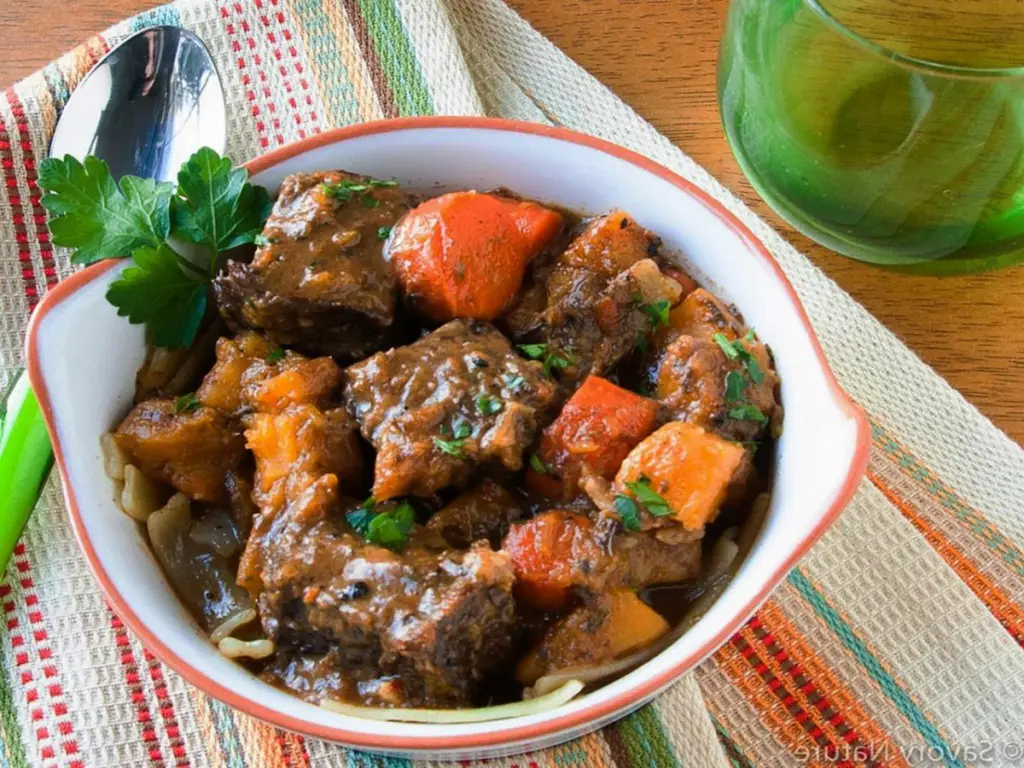
The French National dish is considered to be Pot-au-Feu
Background and History of Pot-au-Feu
- Pot-au-Feu is a classic and iconic French dish, often considered a national dish of France.
- The name “Pot-au-Feu” translates to “pot on the fire” in French, reflecting the method of simmering various ingredients in a pot.
- It has a long history in French cuisine and is known for its simplicity and heartiness.
Ingredients for Homemade Pot-au-Feu
For the broth:
- 4-5 pounds of beef (a mix of marrow-rich bones, chuck roast, and short ribs)
- 1 onion, peeled and studded with 3-4 cloves
- 2-3 leeks, trimmed and cleaned
- 2-3 carrots, peeled
- 2-3 celery stalks
- 2-3 parsnips
- 2-3 turnips
- 1-2 leeks, trimmed and cleaned
- 1 bouquet garni (a bundle of herbs like thyme, parsley, and bay leaves tied together)
- Salt and pepper to taste
For serving:
- Boiled or steamed potatoes
- French baguette or crusty bread
- Dijon mustard
- Cornichons (small pickles)
- Coarse salt
French National dish Recipe – Pot-au-Feu
Making the Broth
- In a large stockpot, place the beef and marrow-rich bones. Cover with cold water, and bring it to a boil.
- As soon as the water reaches a boil, drain it, and rinse the beef and bones under cold water. This helps to remove impurities.
- Return the beef and bones to the stockpot and add enough cold water to cover them again.
- Add the onion with cloves, leeks, carrots, celery, parsnips, turnips, and bouquet garni to the pot.
- Bring the water to a boil, then reduce the heat to a low simmer.
- Skim off any foam or impurities that rise to the surface.
- Simmer the broth for 3-4 hours, occasionally skimming as needed.
- Once the beef is tender and easily falls apart, remove it from the pot and keep it warm.
- Strain the broth, discarding the solids, to get a clear and flavorful broth. Season the broth with salt and pepper to taste.
Serving the Pot-au-Feu
- Serve the broth in bowls, making sure to add a good amount of flavorful broth to each.
- Accompany the Pot-au-Feu with boiled or steamed potatoes and crusty French bread.
- Serve Dijon mustard, cornichons, and coarse salt on the side.
- Slice the beef and serve it alongside the broth, or serve it separately.
Pot-au-Feu is a traditional French dish known for its simplicity and emphasis on high-quality, natural ingredients. It is often considered a comforting and hearty meal, making it a staple of French cuisine.
This dish is often enjoyed with a variety of condiments and side dishes to enhance the dining experience.
French Cuisine – Coq au Vin
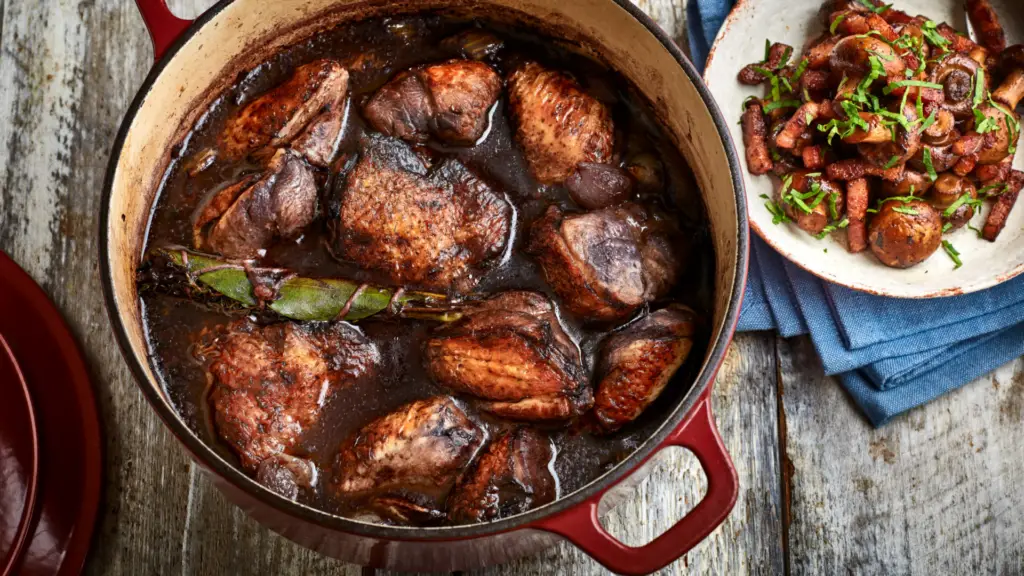
Coq au Vin, a cherished classic of French gastronomy, is a warming symphony of flavors. This sumptuous dish marries tender chicken with the robustness of red wine, enhanced by aromatic herbs and succulent vegetables.
With its origins deep-rooted in the French countryside, Coq au Vin tells a tale of rustic comfort. Its rich sauce, infused with bacon, pearl onions, and mushrooms, transforms simple ingredients into an elegant feast.
It is a timeless favorite perfect for special occasions or cozy dinners alike.
Coq au Vin Ingredients
- 1 whole chicken, cut into 8 pieces (or about 3-4 lbs of chicken thighs and drumsticks)
- 1 bottle of red wine (Burgundy or any full-bodied wine)
- 2 cups chicken stock
- 200g bacon or lardons, chopped
- 12-15 small pearl onions, peeled
- 3 cloves garlic, minced
- 2 cups button mushrooms, quartered
- 2 carrots, sliced
- 1 bouquet garni (a bundle of thyme, bay leaves, and parsley tied together)
- 2 tbsp brandy (optional)
- 2 tbsp tomato paste
- 3 tbsp all-purpose flour
- 3 tbsp unsalted butter
- Salt and pepper, to taste
- Chopped fresh parsley, for garnish
Coq au Vin Cooking Method
Marinating the Chicken
- In a large bowl, combine the chicken pieces, wine, bouquet garni, and a pinch of salt and pepper. Cover and let marinate in the refrigerator for at least 4 hours, preferably overnight.
Preparing the Ingredients
- Remove the chicken pieces from the marinade, patting them dry with paper towels. Reserve the marinade and bouquet garni.
- In a large Dutch oven or heavy-bottomed pot, melt the butter over medium heat. Add the bacon/lardons and cook until browned. Remove and set aside.
- Brown the chicken pieces in the same pot, a few pieces at a time. Set aside.
Building the Stew
- In the same pot, add the garlic, carrots, and pearl onions. Sauté until softened.
- Add the flour, stirring to coat the vegetables.
- Gradually pour in the reserved marinade, chicken stock, brandy (if using), and tomato paste. Stir to combine.
- Return the browned chicken and bacon to the pot. Add the bouquet garni.
- Bring the mixture to a boil, then reduce the heat, cover, and simmer for about 30 minutes.
Adding Mushrooms
- In a separate pan, sauté the mushrooms in a bit of butter until browned.
- Add the mushrooms to the pot and simmer for another 15-20 minutes or until the chicken is tender.
Finishing Touches
- Discard the bouquet garni. Adjust the seasoning with salt and pepper if needed.
- Let the stew sit for a few minutes so the fat rises to the top. Skim off any excess fat.
Coq au Vin Presentation
- Ladle the Coq au Vin into shallow bowls or deep plates.
- Ensure each serving has a mix of chicken, vegetables, and sauce.
- Garnish with chopped fresh parsley for a burst of color and freshness.
- Traditionally, Coq au Vin is served with potatoes, but it also pairs beautifully with crusty French bread or buttered noodles.
Bon appétit!
French Cuisine – Beef Bourguignon

Tender beef, mushrooms, onions, and a rich red wine sauce make up this heart meal. It’s perfect for a cozy night in or a special occasion. Serve with crusty bread or over a bed of mashed potatoes.
Beef Bourguignon Ingredients
- 2 lbs beef chuck, cut into 2-inch cubes
- 6 oz bacon, diced
- 2 medium onions, sliced
- 3 medium carrots, cut into chunks
- 4 cloves garlic, minced
- 1 bottle (750 ml) dry red wine, preferably Burgundy or Pinot Noir
- 2 cups beef broth
- 2 tbsp tomato paste
- 2 tsp fresh thyme leaves (or 1 tsp dried thyme)
- 2 bay leaves
- 1 lb fresh mushrooms, sliced or quartered.
- 12 to 15 small pearl onions, peeled
- 3 tbsp unsalted butter
- 3 tbsp all-purpose flour
- Salt and pepper, to taste
- Fresh parsley, chopped, for garnish
- Olive oil, for frying
Beef Bourguignon Cooking Method
Preparation of meat
- Season beef cubes generously with salt and pepper.
- Heat a few tablespoons of olive oil in a large Dutch oven or heavy-bottomed pot over medium-high heat.
- Add beef cubes in batches, ensuring not to overcrowd the pot, and brown on all sides. Once browned, remove and set aside.
Cooking bacon and vegetables
- Add diced bacon to the pot and cook until crispy. Remove and set aside.
- In the remaining fat, add the sliced onions and carrots. Sauté for about 5 minutes, or until the onions become translucent.
- Stir in garlic and cook for another 1-2 minutes.
Adding liquids and seasonings
- Return the browned beef cubes and bacon to the pot.
- Stir in the tomato paste and cook for a minute.
- Pour in the red wine and beef broth, ensuring the beef is covered.
- Add the thyme and bay leaves.
- Bring the mixture to a boil, then reduce the heat to low, cover, and simmer for about 2 hours or until the beef is tender.
Mushrooms and pearl onions
- In a separate pan, melt 2 tablespoons of butter over medium heat.
- Add the mushrooms and cook until they release their moisture and start to brown.
- In another pan, melt the remaining butter and add the pearl onions. Sauté until they become golden brown.
- Once done, set both mushrooms and onions aside.
Thickening the stew
- In a small bowl, mix flour with a little water to make a smooth paste.
- Stir this paste into the stew to thicken the sauce. If it’s not thick enough, let it simmer uncovered for another 10-15 minutes.
- Add the mushrooms and pearl onions to the pot and stir to combine.
Final seasonings and serving
- Check the seasoning and adjust with salt and pepper as necessary.
- Remove bay leaves before serving.
Beef Bourguignon Presentation
- Serve the Beef Bourguignon hot in deep bowls or plates.
- Garnish with freshly chopped parsley.
- It pairs wonderfully with creamy mashed potatoes, crusty French bread, or buttered egg noodles.
- Optionally, accompany the dish with a glass of the same red wine used in the cooking process.
Bon appétit!
French Cuisine – Ratatouille

This vegetarian dish is a colorful medley of eggplant, zucchini, peppers, and tomatoes stewed together with herbs and garlic. It’s a great way to incorporate the flavors of Southern France into your cooking.
Ratatouille Ingredients
- 1 eggplant (aubergine), diced
- 1 zucchini (courgette), sliced or diced
- 1 yellow squash, sliced or diced
- 1 large onion, diced
- 1 red bell pepper, diced
- 1 yellow bell pepper, diced
- 4 ripe tomatoes, diced
- 4 cloves garlic, minced
- 1/4 cup fresh basil, chopped (or 1 tbsp dried basil)
- 2 tbsp fresh parsley, chopped
- 1 tsp fresh thyme leaves (or 1/2 tsp dried thyme)
- 1/2 cup extra-virgin olive oil
- Salt and pepper, to taste
- 1 bay leaf
- Optional: Red pepper flakes for a little heat
Cooking Method
Eggplant and Zucchini Preparation
- Lightly salt the diced eggplant and let it sit in a colander for about 30 minutes to draw out moisture. Rinse and pat dry.
- Do the same for zucchini if it’s very fresh and watery.
Sautéing Vegetables
- In a large pot or Dutch oven, heat olive oil over medium heat.
- Begin by sautéing onions until they become translucent, about 5 minutes.
- Add the garlic and sauté for another 2 minutes.
- Add peppers and sauté for another 5 minutes or until they start to soften.
Adding Tomatoes and Herbs
- Stir in the tomatoes, basil, thyme, and bay leaf.
- Cook for about 10 minutes, allowing the tomatoes to release their juices.
Adding Eggplant and Squash
- Mix in the eggplant, zucchini, and yellow squash.
- Reduce heat to low, cover, and let it simmer for about 30 minutes, stirring occasionally.
Final Seasonings
- After the vegetables have softened and flavors melded, season with salt, pepper, and optionally, red pepper flakes.
- Stir in the chopped parsley.
- Remove the bay leaf.
Ratatouille Presentation
- Serve the Ratatouille in a deep bowl or on a plate.
- Garnish with a sprig of fresh basil or parsley on top for color.
- Ratatouille can be served hot, room temperature, or even cold, based on preference.
- It pairs well with crusty French bread, rice, or as a side dish to grilled meats.
- For an added touch, drizzle a little extra virgin olive oil on top before serving.
Bon appétit!
French Cuisine – Croque Monsieur

Mam, Gruyere cheese, and béchamel sauce, then grilled to perfection make up this classic sandwich. It’s a great option for a quick lunch or snack.
Croque Monsieur Ingredients
- 8 slices of good-quality white bread
- 8 slices of ham (traditionally Parisian-style cooked ham)
- 8 slices of Gruyère cheese
- 2 cups béchamel sauce (ingredients and method below)
- 1/4 cup grated Gruyère cheese (for topping)
- 2 tbsp unsalted butter, for frying
- Salt and pepper, to taste
- Pinch of nutmeg
For the Béchamel Sauce
- 2 tbsp unsalted butter
- 2 tbsp all-purpose flour
- 2 cups warm milk
- Salt and pepper, to taste
- Pinch of nutmeg
Croque Monsieur Cooking Method
Making the Béchamel Sauce
- In a saucepan, melt the 2 tbsp of butter over medium heat.
- Stir in the flour and cook for about 2 minutes, stirring constantly. This forms a roux.
- Gradually whisk in the warm milk and continue cooking, whisking constantly, until the sauce thickens.
- Season with salt, pepper, and a pinch of nutmeg. Remove from heat and set aside.
Assembling the Sandwich
- Lay out the slices of bread and place a slice of ham and a slice of Gruyère cheese on 4 of them.
- Top with the remaining slices of bread to form sandwiches.
- Spread a thin layer of béchamel sauce on the top of each sandwich.
- Sprinkle the grated Gruyère cheese over the béchamel sauce.
Cooking the Sandwich
- In a frying pan, melt the 2 tbsp of butter over medium heat.
- Once the butter is foaming, add the sandwiches, béchamel side up.
- Cook until the bottom is golden brown, then carefully flip the sandwiches to brown the béchamel side. This should take about 3-4 minutes per side.
Finishing in the Oven (Optional for extra crispiness)
- Preheat the oven to 425°F (220°C).
- Place the browned sandwiches on a baking sheet and bake in the oven for about 5 minutes, or until the cheese on top is bubbly and browned.
Croque Monsieur Presentation
- Serve the Croque Monsieur hot, straight from the oven or pan.
- Cut diagonally for a visual effect, revealing the ham and melted cheese inside.
- Pair with a light salad, cornichons, or some Dijon mustard on the side for those who like a little extra zing.
- Optionally, serve with a glass of white wine or a cold beer.
Bon appétit!
French Cuisine – Quiche Lorraine

Eggs, cream, bacon, and cheese fill this classic French savory pastry dish. It’s perfect for a weekend brunch or a light dinner when served alongside a salad.
Quiche Lorraine Ingredients
- 1 pie crust (store-bought or homemade)
- 4 large eggs
- 1 1/2 cups heavy cream
- 1 cup diced bacon or lardons
- 1 cup grated Gruyère cheese
- 1/4 tsp ground nutmeg
- Salt and pepper, to taste
- Optional: 1 small onion, finely chopped
Quiche Lorraine Cooking Method
Preparing the Pie Crust
- If using a store-bought crust, let it come to room temperature. If making your own, prepare and chill it beforehand.
- Preheat the oven to 375°F (190°C).
- Roll out the pie crust and fit it into a 9-inch pie dish or tart pan.
- Prick the bottom of the crust with a fork to prevent puffing up.
- Bake the crust for about 7-10 minutes, until it’s lightly set but not browned. Remove and set aside.
Cooking the Bacon and Onion
- In a skillet over medium heat, cook the diced bacon or lardons until they’re crispy.
- Remove the bacon and place them on paper towels to drain excess fat. If using onion, sauté in the bacon fat until translucent.
- Distribute the bacon (and onion, if using) evenly over the pie crust.
Preparing the Egg Mixture
- In a mixing bowl, whisk together the eggs, heavy cream, nutmeg, salt, and pepper until well combined.
- Stir in the grated Gruyère cheese.
- Pour this mixture over the bacon in the pie crust.
Baking the Quiche
- Place the pie dish on a baking sheet to catch any spills.
- Bake in the preheated oven for about 35-40 minutes, or until the quiche is set in the center and the top is lightly browned.
- Remove from the oven and let it cool slightly before serving.
Quiche Lorraine Presentation
- Serve Quiche Lorraine warm, cutting it into wedges.
- Place a slice on a plate with a light salad on the side for a classic presentation.
- Garnish the top with a sprinkle of fresh herbs or an extra dash of ground nutmeg for added color and flavor.
- A crisp white wine or a sparkling beverage can complement the rich flavors of the quiche.
Bon appétit!
French Cuisine – Crème Brûlée

A crunchy layer of caramelized sugar tops this decadent dessert. It’s a simple yet elegant dessert that is sure to impress your guests.
Crème Brûlée Ingredients
- 2 cups heavy cream
- 5 large egg yolks
- 1/2 cup granulated sugar (plus extra for the caramelized topping)
- 1 vanilla bean (or 2 tsp vanilla extract)
- Pinch of salt
Crème Brûlée Cooking Method
Preparation
- Preheat your oven to 325°F (165°C).
- Boil a pot of water for a water bath (bain-marie) later.
Infusing the Cream
- Pour the heavy cream into a saucepan.
- Split the vanilla bean lengthwise and scrape out the seeds. Add both the seeds and the pod to the cream. (If using vanilla extract, add it directly to the egg mixture later.)
- Heat the cream over medium-low heat until it’s just about to boil (small bubbles will form around the edge of the saucepan). Remove from heat and set aside.
Mixing Egg Yolks and Sugar
- In a mixing bowl, whisk together the egg yolks, granulated sugar, and a pinch of salt until the mixture is pale and slightly thickened.
Combining the Cream
- Gradually and slowly pour the warm cream into the egg mixture while whisking continuously. This tempers the eggs and prevents them from curdling.
- If you’re using vanilla extract instead of a bean, add it now.
- Strain the mixture through a fine-mesh sieve to remove any lumps and the vanilla pod.
Baking
- Pour the custard mixture into ramekins, filling them almost to the top.
- Place the ramekins into a large baking dish. Pour the boiled water into the baking dish to come halfway up the sides of the ramekins. This water bath helps cook the custard gently.
- Bake in the preheated oven for 40-45 minutes or until the centers are just set but still slightly wobbly.
- Carefully remove the ramekins from the water bath and let them cool to room temperature. Afterward, refrigerate for at least 4 hours or overnight.
Caramelizing the Top
- Sprinkle a thin, even layer of granulated sugar over the surface of each chilled custard.
- Using a kitchen torch, caramelize the sugar by moving the flame in a circular motion until the sugar is melted and forms a golden, crispy top.
- If you don’t have a torch, you can also broil the ramekins in the oven. Watch them closely to ensure the sugar doesn’t burn.
Crème Brûlée Presentation
- Serve the Crème Brûlée in its ramekin.
- The top should be a contrasting dark golden caramel against the pale yellow custard.
- Optionally, garnish with a sprig of fresh mint or a few fresh berries on the side for color.
- Serve with a small spoon to crack through the caramelized sugar top and scoop up the creamy custard below.
Bon appétit!
French Cuisine – A Sweet Treat: Tarte Tatin
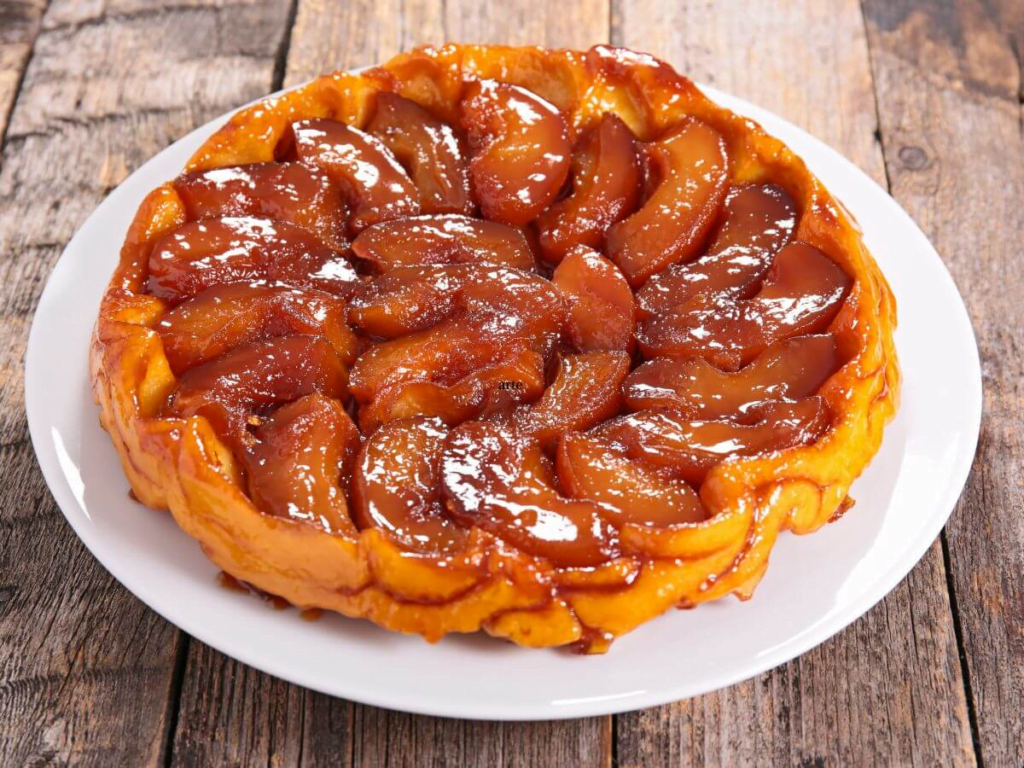
Tarte Tatin, a revered gem of French patisserie, is the epitome of culinary serendipity. Originating from the Loire Valley, this upside-down dessert features luscious caramelized apples atop a golden, flaky puff pastry.
Legend holds that it was born from a kitchen mishap by the Tatin sisters. Instead of lamenting a ruined pie, they improvised, leading to this celebrated creation.
Perfectly balancing sweetness with a touch of tartness, Tarte Tatin is a delightful testament to the magic of French baking.
Tarte Tatin Ingredients
- 6-8 medium-sized apples (traditionally, tart varieties like Granny Smith)
- 1 cup granulated sugar
- 6 tbsp unsalted butter
- 1 tsp vanilla extract or 1 vanilla bean
- 1 sheet of puff pastry (store-bought or homemade)
- A pinch of salt
Tarte Tatin Cooking Method
Preparing the Apples
- Peel, core, and halve the apples.
- In a large bowl, toss them with half of the sugar and let them sit for about 20 minutes to release some of their juices.
Caramel Preparation
- In a 10-inch, oven-safe skillet or tarte tatin pan, melt the butter over medium heat.
- Stir in the remaining sugar and salt.
- Cook, stirring occasionally, until the mixture becomes a deep golden caramel, about 8-10 minutes.
- If using a vanilla bean, split it lengthwise, scrape out the seeds, and add both the seeds and the pod to the caramel. If using vanilla extract, add it directly.
- Remove from heat.
Arranging the Apples
- Carefully arrange the apple halves in the skillet, flat side down, forming a circular pattern.
- Return the skillet to medium heat and cook the apples in the caramel for about 15-20 minutes, or until they’re slightly softened.
- Remove from heat and let it cool slightly.
Preparing the Puff Pastry
- Roll out the puff pastry to about 1/4-inch thickness and cut a circle slightly larger than the diameter of your skillet.
- Place the puff pastry circle over the apples in the skillet, tucking the edges down around the apples.
Baking
- Preheat the oven to 375°F (190°C).
- Place the skillet in the oven and bake for 25-30 minutes, or until the puff pastry is golden brown and has puffed up.
- Remove from the oven and let it sit for 5 minutes.
Inverting the Tarte
- Place a large serving plate over the skillet. Using oven mitts, carefully and quickly invert the skillet, allowing the tarte to fall onto the plate. If any apples stick to the skillet, simply place them back onto the tarte.
Tarte Tatin Presentation
- The Tarte Tatin should be presented with the caramelized apples on top and the puff pastry on the bottom.
- It can be served warm or at room temperature.
- Pair with a dollop of crème fraîche, whipped cream, or a scoop of vanilla ice cream for added indulgence.
- Optionally, sprinkle with powdered sugar or a drizzle of caramel sauce.
Bon appétit!
With these classic French recipes, you can bring the flavors of France into your own kitchen. Don’t be intimidated by the French culinary techniques, embrace them and let the rich traditions of French Cuisine inspire your cooking.
Conclusion
We hope you enjoyed our culinary journey into the world of French Cuisine. From exploring traditional dishes to unraveling culinary traditions and mastering cooking techniques, French gastronomy has a way of capturing the heart and mind of food enthusiasts.
Trying classic French recipes at home is a great way to experience the flavors of France in your own kitchen. And for those willing to indulge in the artistry of French gastronomy, Michelin-starred restaurants offer a glimpse into the highest levels of culinary innovation and perfection.
French Cuisine has a rich cultural history that has influenced the global food scene. It is a cuisine that reflects the unique terroir of each region and the passion of the people who create it.
In conclusion, we invite you to embrace the flavors, savor the traditions, and enjoy the richness of French gastronomy. Whether it’s indulging in a croissant for breakfast, sipping a glass of Bordeaux with dinner, or trying your hand at a classic recipe, French Cuisine is sure to satisfy your taste buds and leave a lasting impression on your culinary experiences.
FAQ’s
What is French Cuisine known for?
French Cuisine is known for its rich traditions, cooking techniques, and flavors that have made it a global sensation. It is famous for dishes like Coq au Vin, Ratatouille, and the art of pastry-making.
What is the National Dish of France
Pot-au-Feu is considered to be the National Dish of France
What are some traditional French dishes?
Some traditional French dishes include Coq au Vin, Ratatouille, Bouillabaisse, Escargots, and Quiche Lorraine.
What are French cooking techniques?
French cooking techniques include sautéing, braising, roasting, poaching, and flambéing. These techniques are used to create the distinct flavors and textures found in French dishes.
Can you share some classic French recipes?
Sure! Here are a few classic French recipes for you to try at home: Beef Bourguignon, Coq au Vin, Quiche Lorraine, Ratatouille, and Crème Brûlée.
What is the cultural significance of French Cuisine?
French Cuisine has a central role in French culture and has influenced the global food scene. The culinary history of France has shaped the way we perceive food and has given rise to numerous culinary traditions.


The articles you write help me a lot and I like the topic
May I have information on the topic of your article?
Your articles are very helpful to me. May I request more information?